South Korea
Country Overview
South Korea is the world’s 11th largest economy and the fourth largest in Asia. It has strong technological infrastructure, a well-developed e-commerce culture, and highly consolidated channels to market with 50 million potential consumers. South Korea is a fast-paced, trend-setting market where industry is dominated by globally significant players.
Rapid growth and a strong free trade agreement make South Korea an attractive market for New Zealand exporters. It’s important to understand how to navigate the nation’s hierarchical business culture.
The majority of Korea’s most affluent consumers are aged 40-49. They enjoy high social status, are familiar with digital technologies, are sensitive to trends, and put a premium on practicality. The internet is widely used as a marketing tool and sales channel.
Trade agreements
The 2015 New Zealand-Korea Free Trade Agreement gives New Zealand exporters significant commercial benefits. Following a 2017 tariff reduction, two-thirds of our exports now enter Korea duty free. Tariffs will be eliminated in stages on around 98% of New Zealand’s current exports to Korea. The FTA provides open, competitive and non-discriminatory access to government contracting opportunities, and free and open flows of investment between the two countries.
New Zealand services exporters benefit from substantially improved market access, including streamlined and transparent procedures for travel and visas.
Country intelligence
The Robinson Country Intelligence Index is a holistic measurement of country-level risk and serves as an alternative measure of country development. It incorporates four broad dimensions of Governance, Economics, Operations and Society. A higher ranking indicates a better Country Intelligence Index score.

Value of New Zealand exports

International logistics performance
The International Logistics Performance Index measures how efficiently countries move goods across and within borders. Countries are ranked on their index score with a higher ranking indicating higher performance of trade logistics based on six components: customs, infrastructure, ease of international shipments, logistics services quality and competence, tracking and tracing, and timeliness.

Income and distribution of wealth
Global National Income (GNI) per capita is the dollar value of a country's final income in a year, divided by its population.
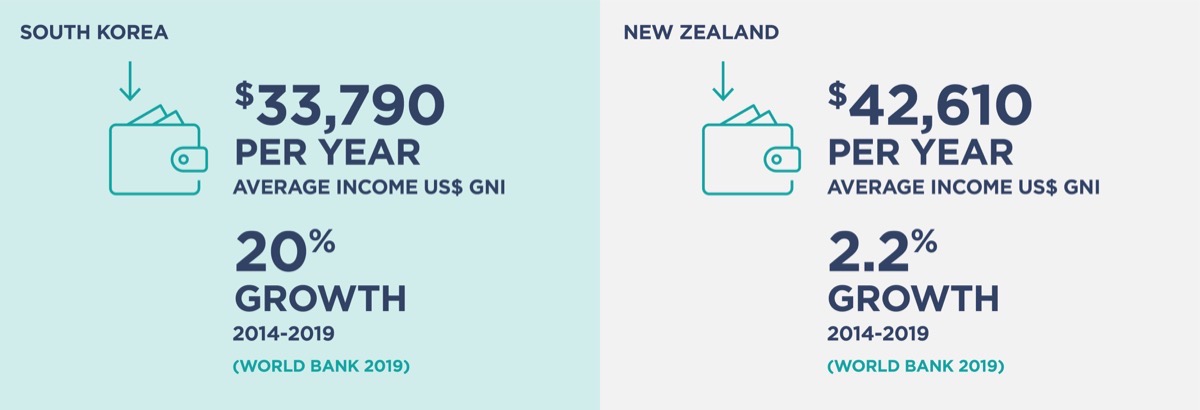
Annual Disposable Income refers to gross income minus social security contributions and income taxes. Each income band presents data referring to the percentage of households with a disposable income over that amount.
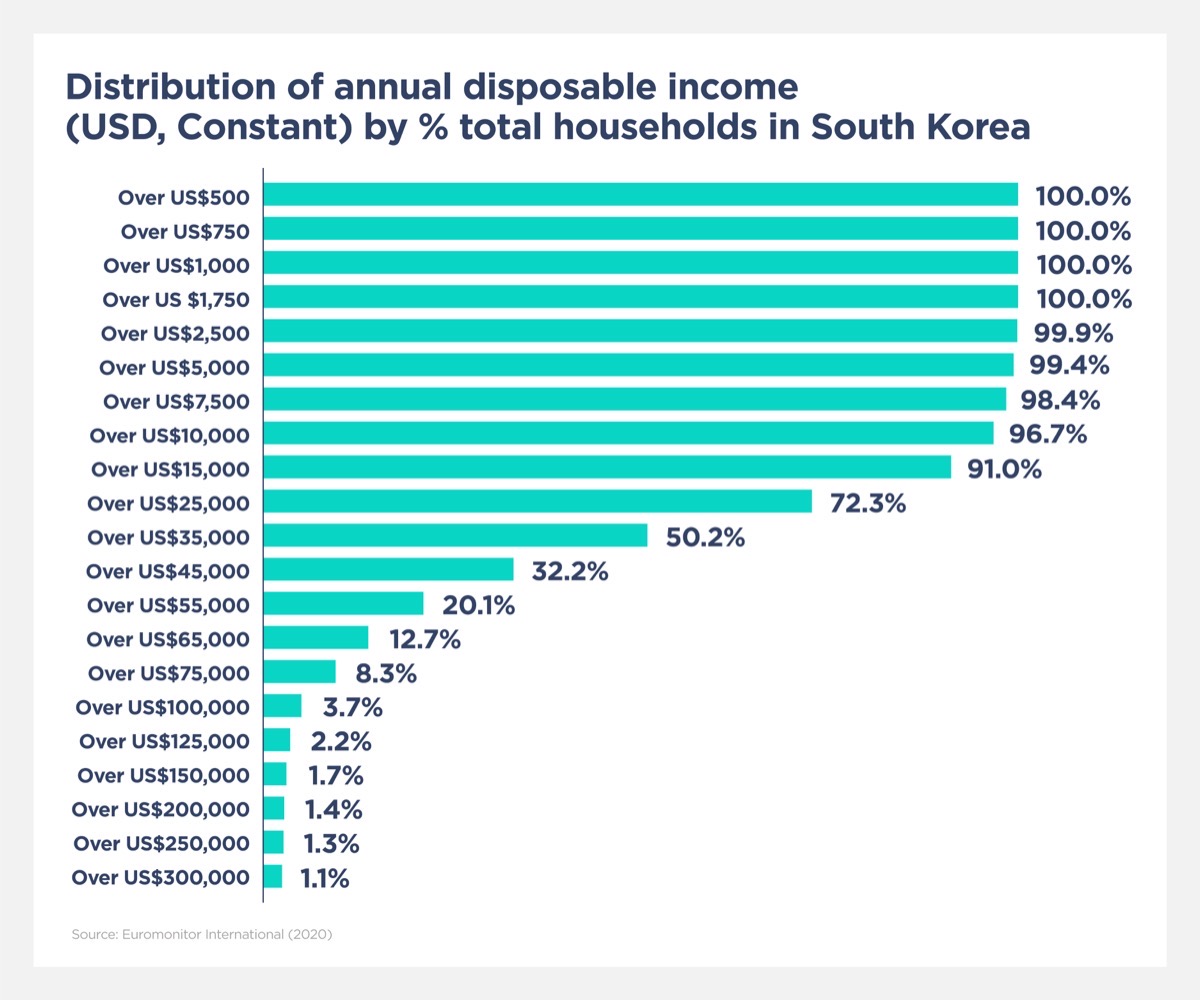
Further information
For more information to validate South Korea as an export market, see our South Korea Market Guide.
- Vitamins & Dietary Supplements
- Skin Care
- Dog & Cat Food
- Alcoholic Drinks
- Health & Wellness Packaged Food & Beverages
Vitamins & Dietary Supplements
- Market size and growth
-
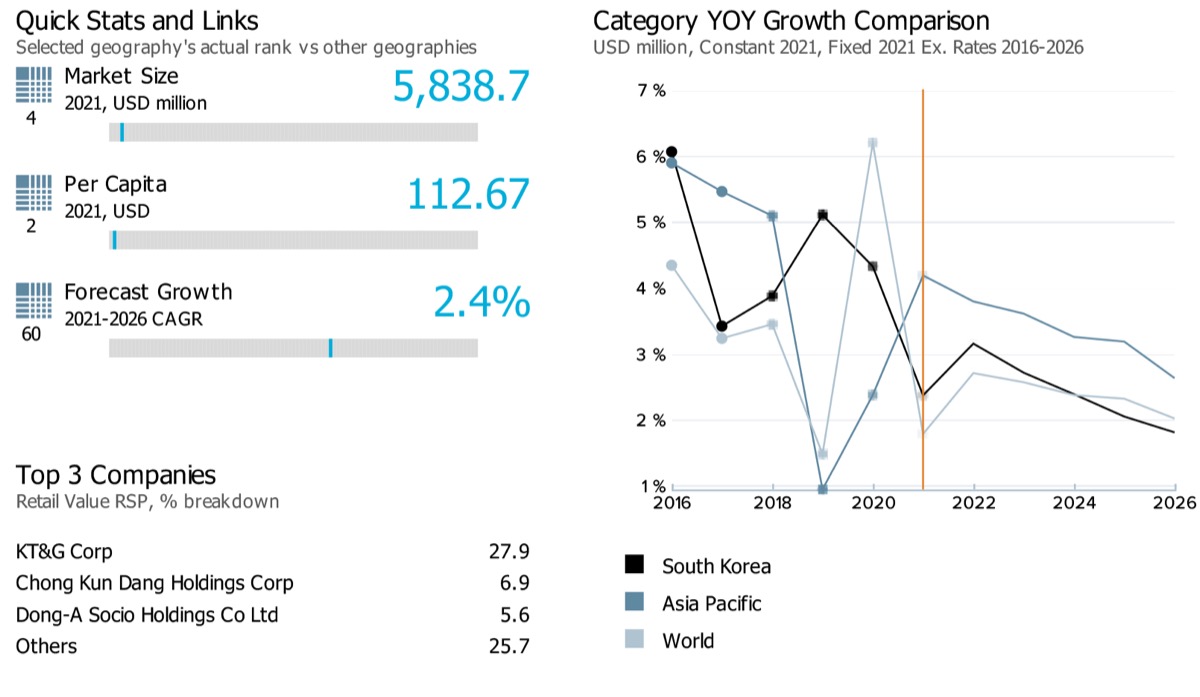
Note: Data on the top left corner of the image (4, 2, and 60) showcases respective ranks for South Korea for its market sizes, per capita, and forecast growth rate compared against 99 countries globally. The blue line on the grey bar represents the relative position of the country as per their rank.
Note: Latest market size data for the year 2021 has been shared for Vitamins & Dietary Supplements
Retail value sales of vitamins and dietary supplements in South Korea witnessed a historic compound annual growth (CAGR) of 4.9% during 2016-2021. It is further expected to witness a slowdown in retail value CAGR and grow at 2.4% over 2021-2026. The expected slowdown is mainly in line with the global performance of the category, where it witnessed a historic CAGR of 5.1% and an estimated slowdown for the forecast CAGR of 2.4% over the same period for its retail value sales.
- Sub-category breakdown
-
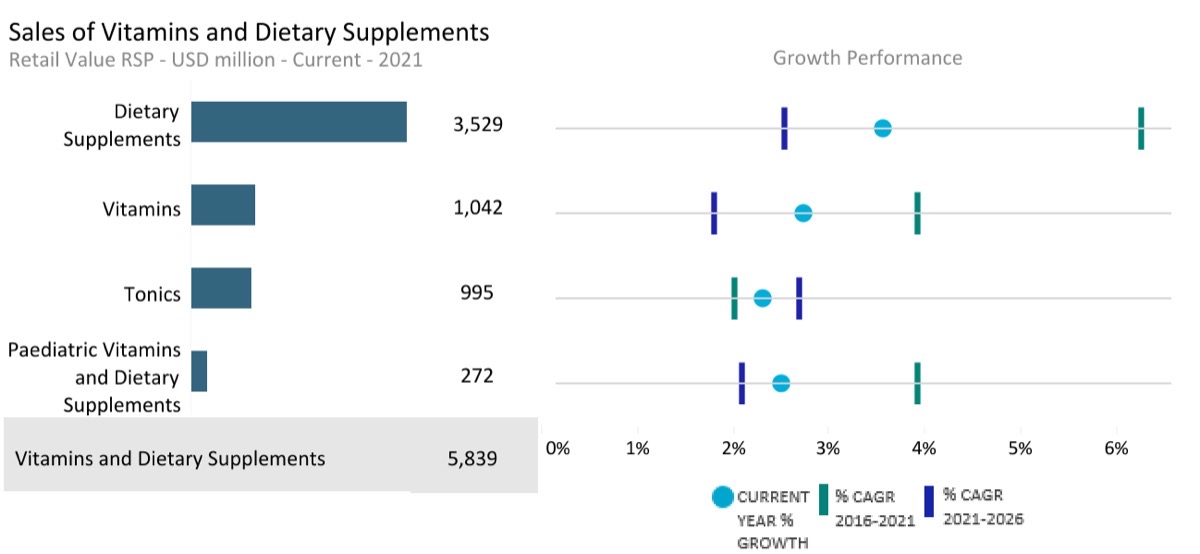
Note: Current year growth in the above chart refers to the period 2021-22
Category
Unit
Market size (2021)
Retail value RSP
Forecast compound annual growth rate (2021/2026) %
Vitamins and Dietary Supplements
USD million
5,838.711
2.41
Vitamins
USD million
1,041.85
1.79
Paediatric Vitamins and Dietary Supplements
USD million
272.31
2.09
Dietary Supplements
USD million
3,529.24
2.53
Tonics
USD million
995.31
2.69
- Channel distribution
-
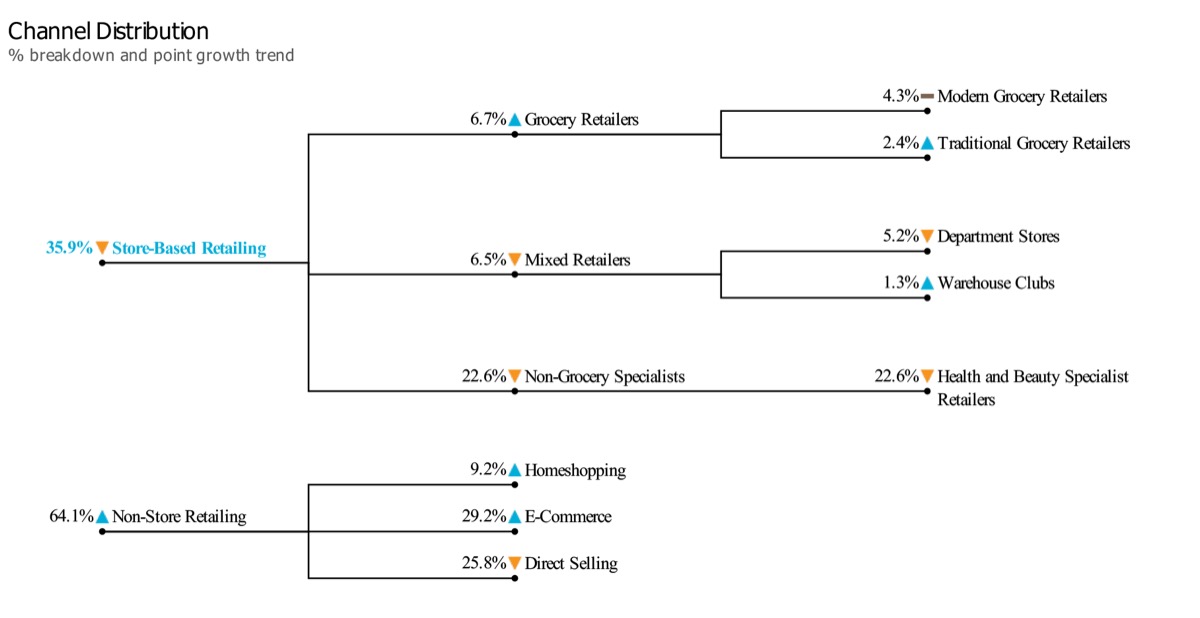
Note: The chart here showcases the retail value share of different channel sales for Vitamins and dietary supplement products in South Korea in 2021. The triangle/dash represents whether the specific channel share has increased/decreased or remained the same against its share in the previous year
- Market Insights
-
Market trends
- Vitamins were favourably impacted by the outbreak of COVID-19 in 2020. Sales of vitamin B rose at a fast pace in the first half of 2020, with the merits of both vitamin B and C shared widely across social media and through press releases. In addition, vitamin D also received positive press stories, linking to its impact on the immune system. Multivitamins also performed well as consumers appreciate these for their convenient appeal of offering everything a consumer needs in one tablet.
- Dietary supplements have not yet reached maturity and are still developing in terms of product types and segmentation. Consumers in 2021 are seeking several popular products, such as probiotic supplements, eye health supplements and ginseng, and domestic brands focus on these popular options. Furthermore, consumers are starting to show more interest in a diverse range of products, including fish oils/omega fatty acid and other marine-based oils, with krill oil products becoming particularly popular.
Prospects and growth opportunity
- As the virus has increased interest in health and wellbeing across the country, dietary supplements are expected to record strong growth over the forecast period to 2026. As such, probiotic supplements are set to drive the bulk of growth over the coming years. This is largely in line with consumers becoming increasingly interested in the product's benefits on the immune system. In addition, wider education surrounding the link between gut health and overall health and wellbeing is also expected to boost sales. This will be positive for probiotics while becoming a challenge for digestive remedies, as consumers reach for probiotics as a preventative measure.
- Vitamins' value growth is set to remain positive and steady over the forecast period, with vitamin C and vitamin B recording the best performances. As consumers are expected to remain wary of the COVID-19 virus in the early forecast period, many will continue purchasing vitamins, with growth in 2021 expected to be slightly higher than that in 2020. In addition, attention given to vitamins throughout 2020 will help vitamins perform well even over the early forecast period.
General health & wellness trends
- Consumer demand is expected to become more focused on specific formats. South Koreans are increasingly seeking formats that can be easily swallowed, many opting for the convenient daily dose of one multivitamin. Therefore, other formats that are easier to consume than tablets, such as chewable vitamins and powder options, are expected to become more popular over the coming years.
- The COVID-19 pandemic is expected to encourage further interest in health and wellness, shaping future shopping habits accordingly. Therefore, while OTC (over the counter) goods will continue to be impacted by factors such as new regulations, new product launches, and challenges from Rx prescription products, vitamins and dietary supplements have massive potential for growth, aligned to the health and wellness trend. Consumer education will be more significant, and ingredients that were not popular during the review period, such as St John’s Wort, echinacea and mushroom extract, are expected to show growth across the coming years.
Skin Care
- Market size and growth
-
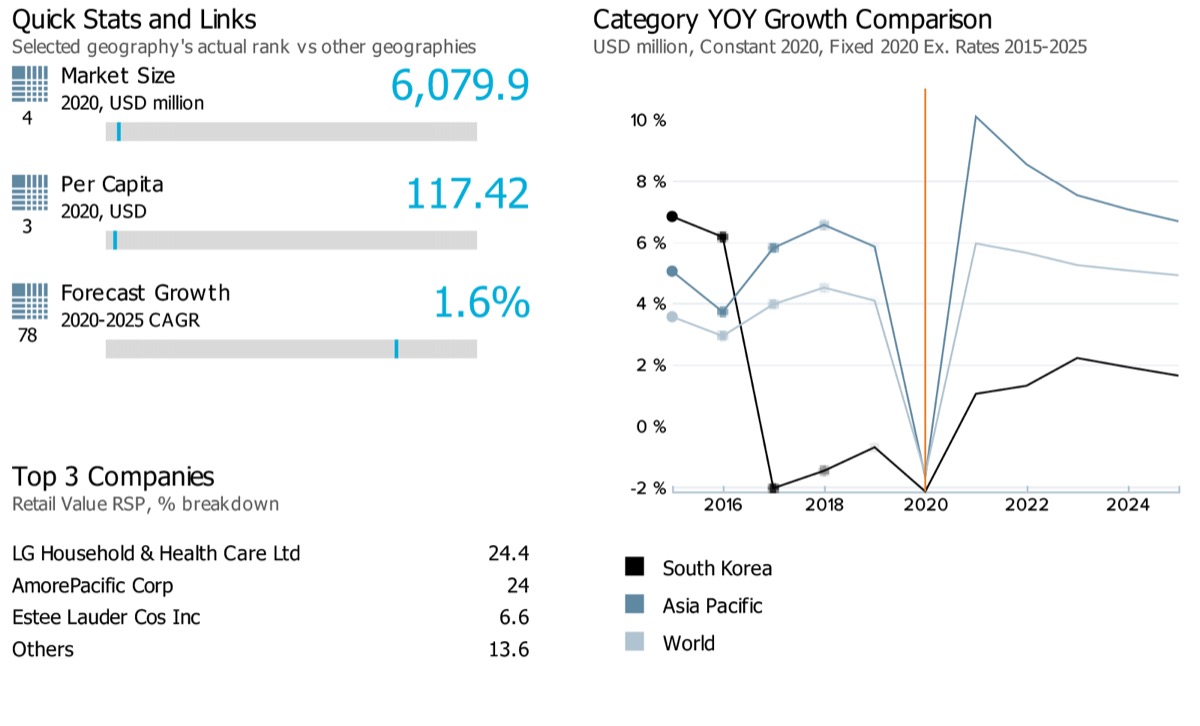
Note: Data on the top left corner of the image (4, 3, and 78) showcases the respective ranks for South Korea for its market size, per capita, and forecast growth rate compared against 99 countries globally. The blue line on the grey bar represents the relative position of the country as per their rank.
Retail value sales of skin care products in South Korea are expected to witness an increased compound annual growth rate (CAGR) over the forecast period (CAGR: 2020-2025: 1.6%) against its performance over the historic period (CAGR: 2015-2020: 0.9%). However, globally, the category’s performance is expected to be stronger against its performance in South Korea, both over the historic (CAGR: 2015-2020: 4.7%) and forecast period (CAGR: 2020-2025: 5.3%).
- Sub-category breakdown
-
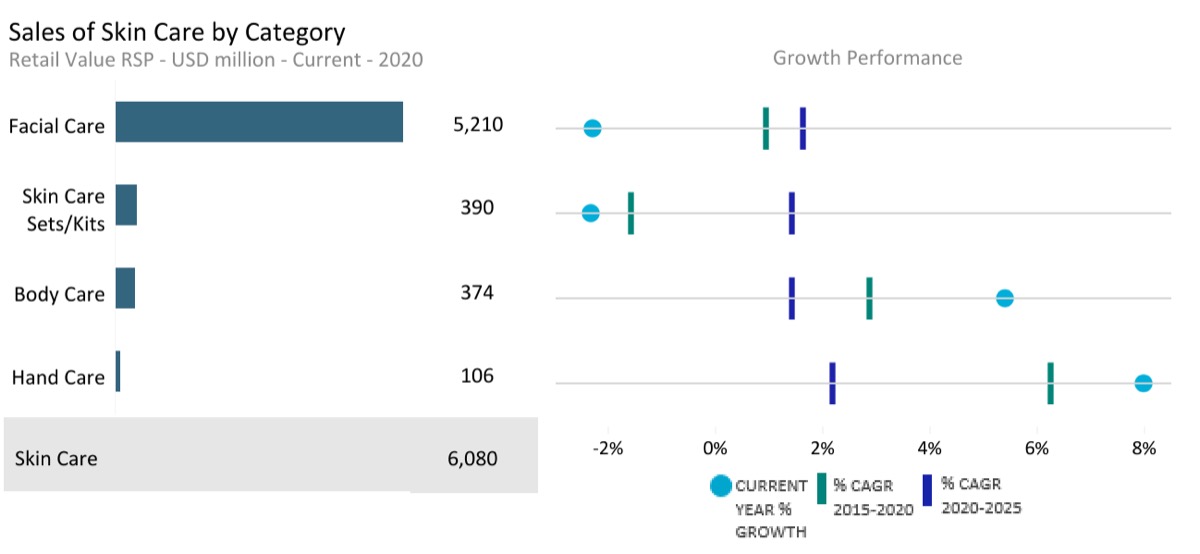
Note: Current year growth in the above chart refers to period 2019-20
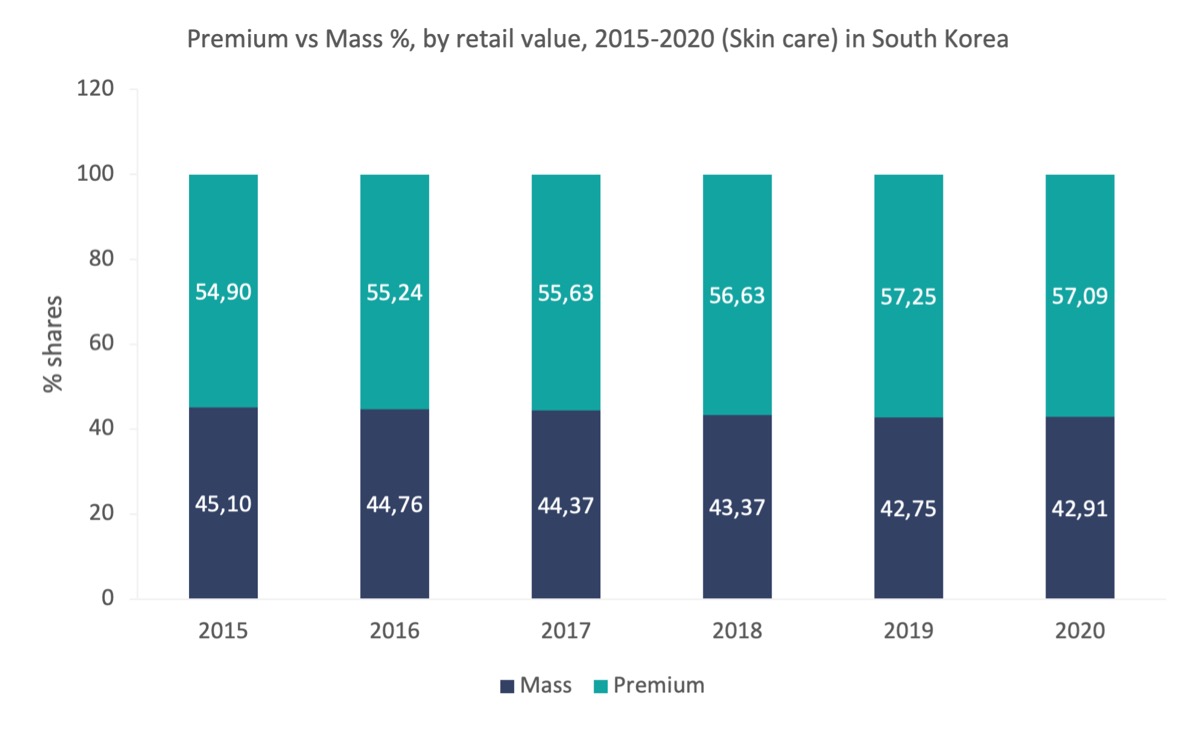
Category
Unit
Market size (2020)
Retail value RSP
Forecast compound annual growth rate (2020/2025) %
Skin Care
USD million
6,079.86
1.61
Body Care
USD million
373.53
1.42
Facial Care
USD million
5,209.94
1.62
Hand Care
USD million
106.39
2.18
Skin Care Sets/Kits
USD million
390.00
1.41
- Channel distribution
-
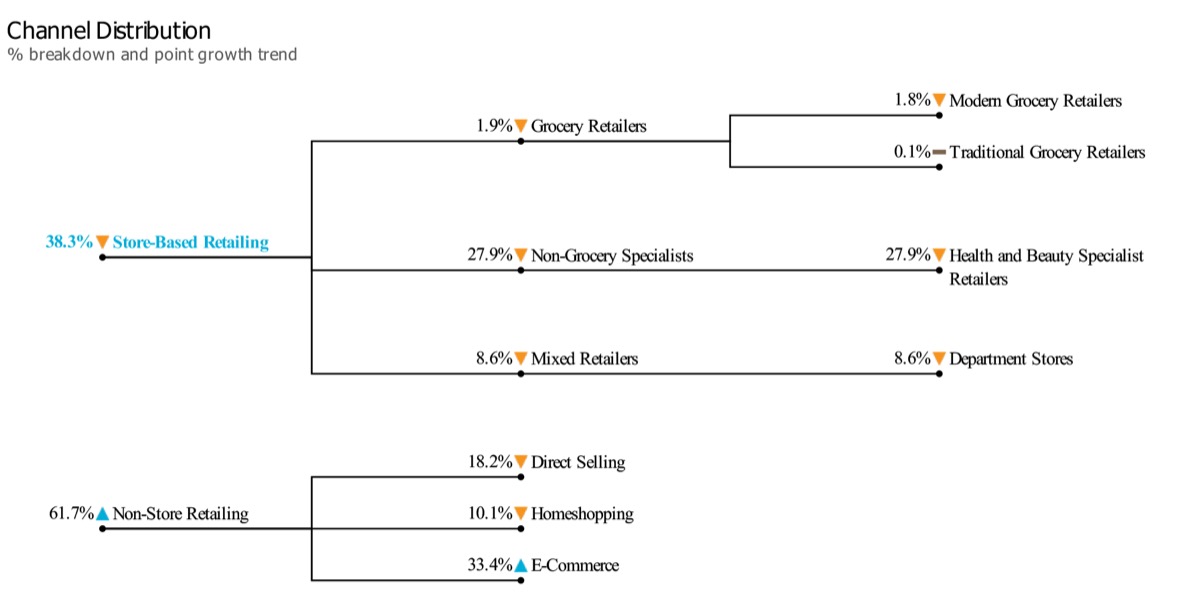
Note: The chart here showcases the retail value share of different channel sales for skin care products in South Korea in 2020. The triangle/dash represents whether the specific channel share has increased/decreased or remained the same against its share in the previous year.
- Market Insights
-
Market trends
- In 2020, “soothing” was a key theme in skin care products as consumers sought to purchase products to relieve skin problems, many of which were either caused or exacerbated by the frequent use of face masks throughout the pandemic. Skin care products containing skin-soothing ingredients such as panthenol, tea tree, cica, and Houttuynia cordata gained popularity in 2020 as more and more consumers have been suffering from skin problems due to the prolonged usage of face masks.
- The COVID-19 pandemic has also accelerated the polarisation of skin care products, with sales of discounted and premium products performing the best in the category. Many consumers were attracted to special priced products in 2020, with a growing trend towards products with more reasonable prices as consumers sought to reduce their spending. In this sense, sales of products consisting of buying one get one free deal or deals that offered free gifts became more popular as consumers felt that, with these deals, they were getting more for their money.
- The biggest development throughout the beauty and personal care in South Korea, as in many other countries, was the surge in demand for products sold through e-commerce channels. Skin care is no exception to this trend, with skin care sales through e-commerce channels recording a dramatic increase in 2020. Another key development in distribution terms in 2020, however, was the growing range of skin care products that were made available through convenience stores. The convenience stores in South Korea emerged as a beauty and personal care retailer and a retailer for food and daily essentials.
Prospects and growth opportunity
- Over the forecast period to 2025, consumers are expected to be more interested in products marketed as “clean beauty”. Demand for products that avoid harmful ingredients and vegan products has increased over the review period in many categories in beauty and personal care. Over the forecast period, however, these trends will be increasingly noticeable in skin care as interest in health and the environment continues to rise in South Korea. More rigorous certification processes will also support such development. For example, On 16 September 2019 Korea Testing & Research Institute started to govern and issue two new types of certification: Natural and Organic BPC certification – authorised by the Ministry of Food and Drug Safety. Following the introduction of this certification standard, products now need to satisfy natural/naturally-orientated ingredients of 95% and over.
- The experience of the COVID-19 pandemic is also expected to drive trends for products that claim to support skin immunity over the forecast period. In line with this trend, companies are expected to incorporate recognisable ingredients that consumers will know from functional food products as immunity boosters. This trend will be supported by the continued threat of the COVID-19 pandemic over the forecast period to 2025, with face masks expected to be an important element of daily life in South Korea in 2021 and 2022.
General health & wellness trends
- Skin care will be an important category over the forecast period to 2025, as the continued use of face masks in South Korea will mean that consumers will need more products to treat skin problems associated with face masks. Local brands such as Hera, Ohui, and Dr. Jart+ have already launched products that target the skin’s microbiome, and others are expected to follow over the forecast period. There is considerable potential for products aimed at improving skin health whilst using face masks, as face masks are expected to become a common feature of life over the forecast period.
- The relatively new concept of microbiomics is expected to continue playing an important role in innovation and product development in skin care over the forecast period. This approach to skin care involves supporting the healthy growth of beneficial microorganisms to support skin health. Microbiome products aim to maintain strong skin health and immunity by promoting a good balance of healthy microorganisms in the skin, as a poor balance of microorganisms makes the skin more vulnerable to external irritation. Global and domestic players alike, such as AmorePacific, LG Household & Health Care Ltd, Dr Jart+ and Tony Moly Co Ltd, have already launched products using microbiome technology, and more are expected to emerge in the coming years.
Dog & Cat Food
- Market size and growth
-
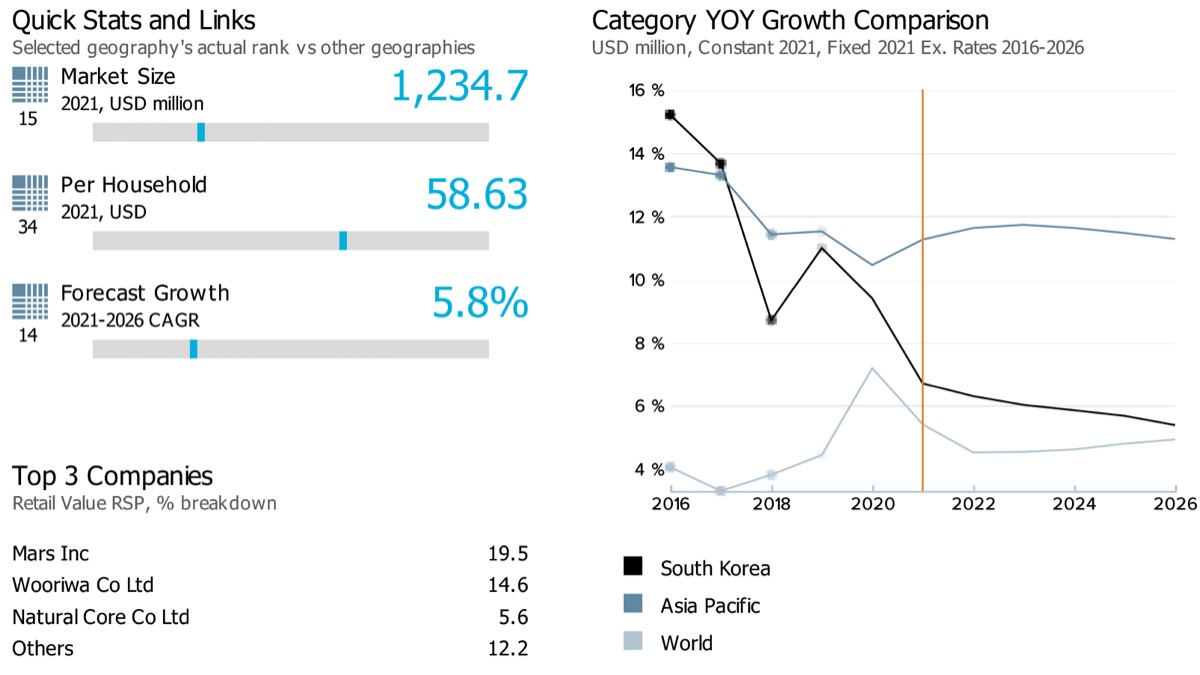
Note: Data on the top left corner of the image (15, 34, and 14) showcases respective ranks for South Korea for its market size, per capita, and forecast growth rate compared against 53 countries globally. The blue line on the grey bar represents the relative position of the country as per their rank.
Note: Latest market size data for the year 2021 has been shared for Dog and Cat food
Performance of retail value sales of dog and cat food in South Korea is estimated to slow down from a historic compound annual growth rate (CAGR) of 11.0% during 2016-2021 to an estimated forecast CAGR of 5.8% over 2021-2026. The category’s performance in the country has been stronger than its global performance. Globally, the category witnessed a historic CAGR of 6.9% and an estimated forecast CAGR of 4.7% over the same time.
- Sub-category breakdown
-
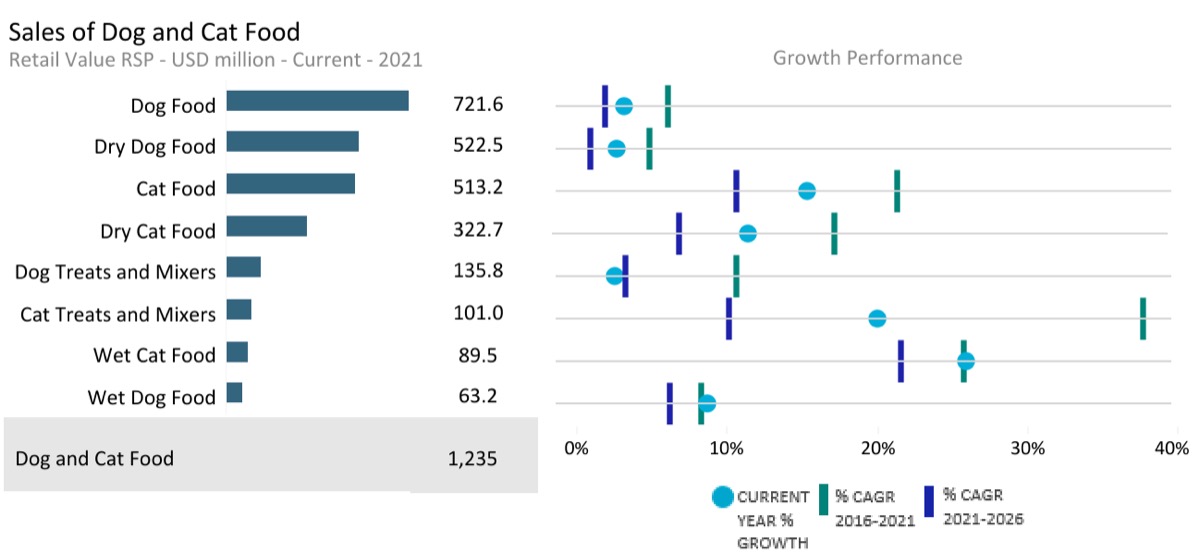
Note: Current year growth in the above chart refers to period 2020-21
Category
Unit
Market size (2021)
Retail value RSP
Forecast compound annual growth rate (2021/2026) %
Dog and Cat Food
USD million
1,234.70
5.83
Dog Food
USD million
721.55
1.84
Dog Treats and Mixers
USD million
135.82
3.22
Dry Dog Food
USD million
522.51
0.87
Wet Dog Food
USD million
63.22
6.22
Cat Food
USD million
513.15
10.59
Wet Cat Food
USD million
89.49
21.52
Dry Cat Food
USD million
322.66
6.77
Cat Treats and Mixers
USD million
101.00
10.16
- Channel distribution
-
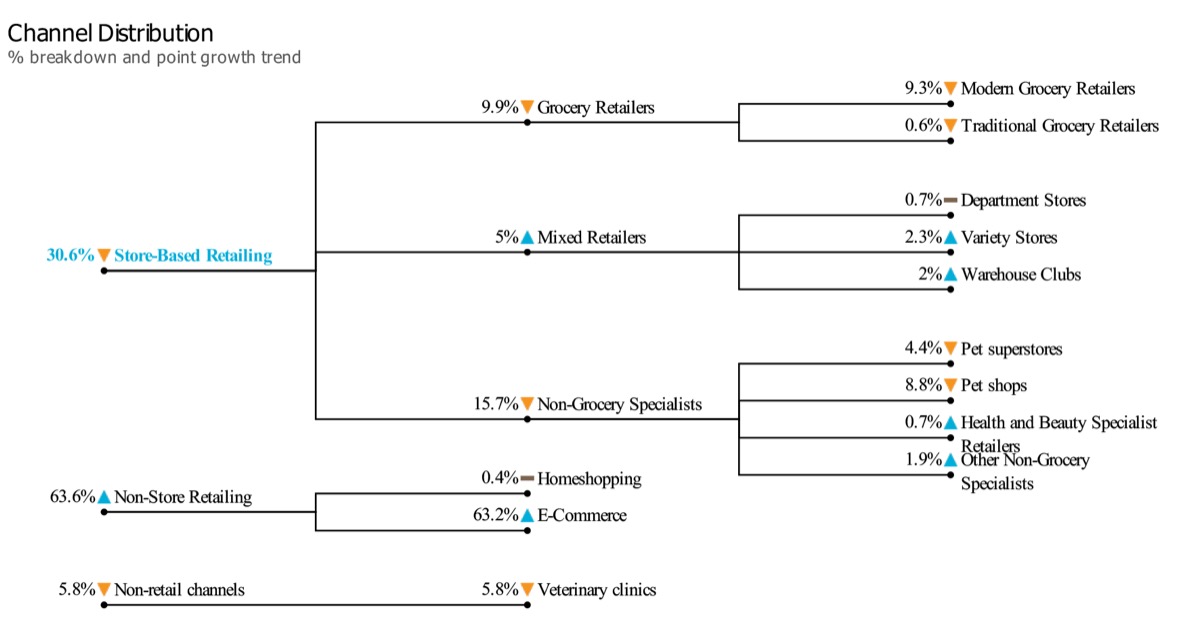
Note: The chart here showcases the retail value share of different channel sales for dog and cat food products in South Korea in 2021. The triangle/dash represents whether the specific channel share has increased/decreased or remained the same against its share in the previous year
- Market Insights
-
Market trends
- With revised regulations regarding animal welfare, the number of breeders and pet care factories in South Korea has decreased. As a result, the total dog population saw growth slow during the review period, thus impacting sales for pet food. Also, a handful of COVID-19 cases amongst dogs globally saw heavy media coverage in 2020, with two dogs in Hong Kong being found to have the virus in March of the year. This also deterred some people from acquiring dogs. Pet insurance also became compulsory for several dog breeds such as Tosas, Staffordshire Bull Terriers, American Pit Bull Terriers, American Staffordshire Terriers and Rottweilers from 2021.
- As a result of these trends, dog food will see considerably slower retail volume and current value growth in 2021 compared to the compound annual growth rate from 2016-2021. Economy dry dog food will be impacted by a decline in the number of low-end dog breeders and farms and those keeping dogs for purposes other than as pets, seeing retail volume and current value decline in the year.
- The cat population, on the other hand, has benefited from many younger people, or those who live alone, preferring cats due to their lower care and food requirements in comparison to dogs. These cat owners often have highly indulgent attitudes toward their feline companions, which intensifies further towards the end of the review period (2016-2021) as most spent more time at home with their pets. There is also a growing focus on offering optimum nutrition to keep pet cats healthy. This will support double-digit retail volume growth for premium dry and wet cat food in 2021.
Prospects and growth opportunity
- Over the forecast period to 2026, the government is set to enforce new regulations covering pet owners, in line with its five-year plan announced in 2020. From 2022, prospective owners will only be able to acquire pets after completing a mandatory animal welfare course, with animal welfare also being added to the school curriculum. Dog owners will be prohibited from keeping dogs on a short leash at home and confining them in rooms with little light.
- As dog ownership becomes better regulated on account of strict government regulations, growth in the dog population is expected to slow further in the forecast period. These trends will inevitably impact dog food sales growth, with retail volume sales likely to see only a marginal forecast compound annual growth rate for 2021-2026. Economy dry dog food will be affected most heavily, being the dog food most likely to be adopted by dog farms, less caring owners and those keeping dogs as farm animals or for security, seeing retail volume decline as a result.
- Premium dry cat food will remain the most significant product area in cat food in the forecast period and will see a double-digit current value growth. For pet cats, the cat butler trend will intensify over the forecast period, with owners treating cats as if they were the master and the owner the butler or servant. These owners will actively search for the optimum ingredients, origins, functions and search for products that meet their cat’s needs.
General health & wellness trends
- Pet care is expected to see ongoing strong growth in the forecast period, benefiting from consumers’ growing focus on pet welfare and a further rise in the pet population. There are, however, some potential constraints to growth. COVID-19 virus cases were found among some pet dogs and cats, which may deter some from acquiring such pets, at least at the start of the forecast period. In addition, stronger regulation will be introduced, with the government also increasingly focused on pet welfare, which will likely result in slower growth in the pet dog and cat population.
- With slowing growth in the pet dog population, dog food manufacturers will also increasingly focus on offering high quality and distinctive products to gain share in the forecast period, rather than expanding overall retail volume sales of dog food. As a result, premium dog food is expected to see considerable innovation in food- based on insect proteins, clean and ingredients and simple recipes to minimise the chance of allergies and the use of functional ingredients.
Alcoholic Drinks
- Market size and growth
-
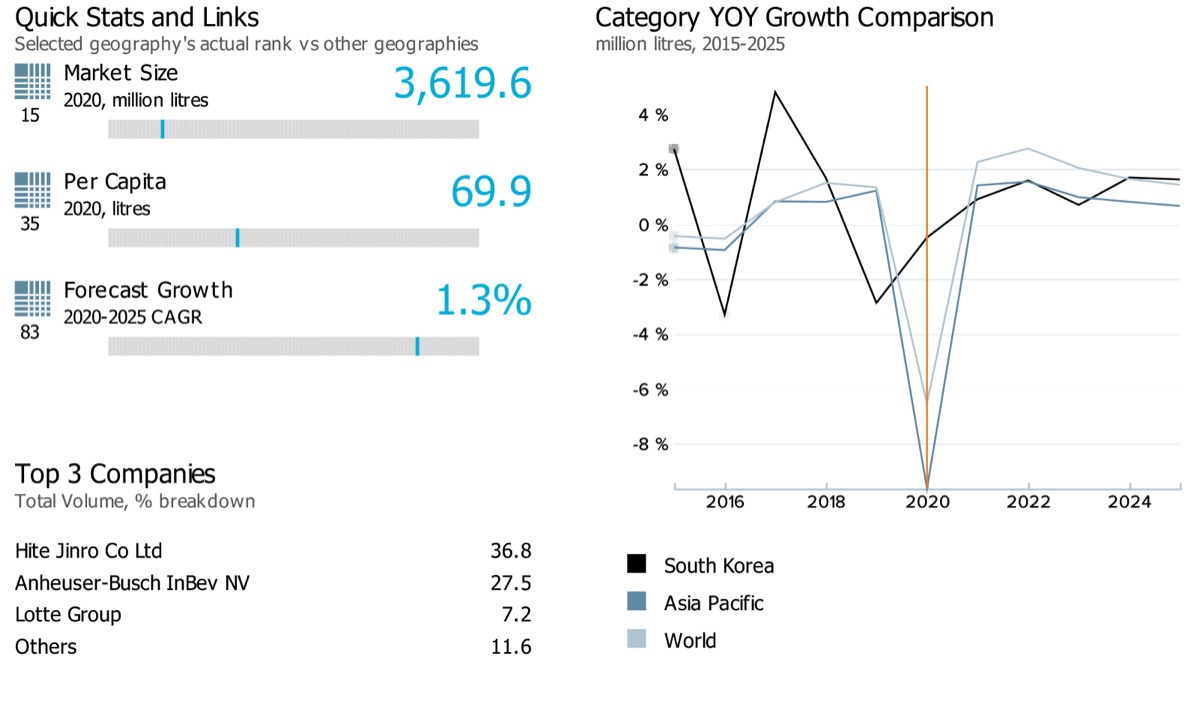
Note: Market size data for the alcoholic drinks category in the country reflects the total volume in a million litres. Data on the top left corner of the image (15, 35, and 83) showcases respective ranks for South Korea for its market size, per capita, and forecast growth rate compared against 99 countries globally. The blue line on the grey bar represents the relative position of the country as per their rank.
The compound annual growth rate (CAGR) for alcoholic drinks in South Korea, both in terms of total value and volume, is expected to gain momentum over the forecast period (2020-2025: FCAGR for total value: 2.6% and for total volume: 1.3% ) against its performance in the historic period (2015-2020: HCAGR for total value: -0.5% and for total volume: -0.1% ). This is mainly in line with the category’s performance at the global level, where both in terms of total value and volume, alcoholic drinks are expected to gain momentum over the forecast period (2020-2025: FCAGR for total value: 4.6% and for total volume: 2.0% ) against its performance in the historic period (2015-2020: HCAGR for total value: 0.9% and for total volume: -0.7% )
- Sub-category breakdown
-
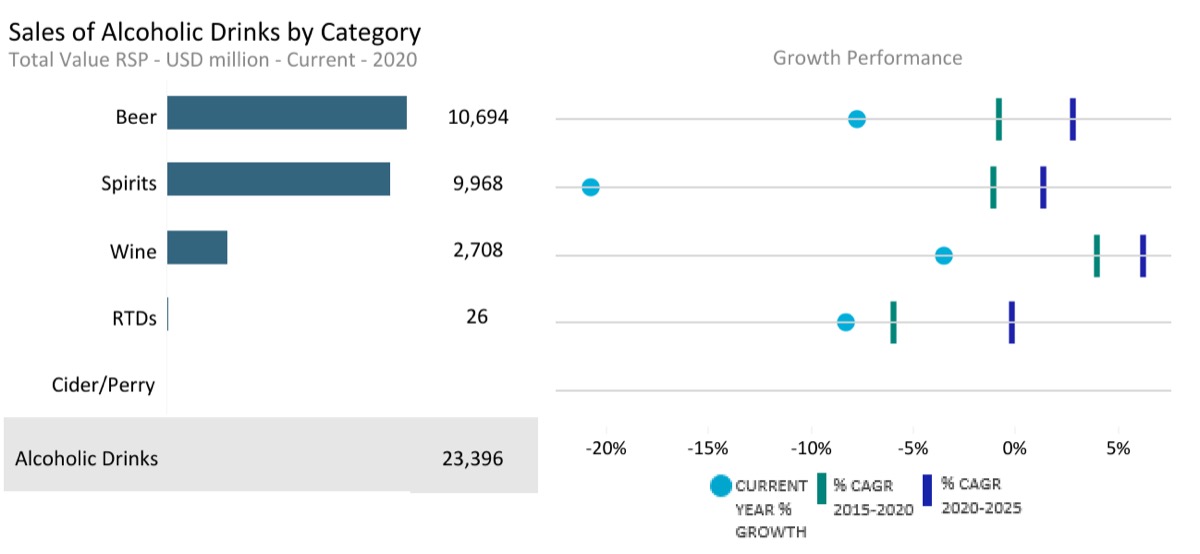
Current year growth in the above chart refers to the period 2019-20
Category
Data type
Market size (2020)
USD million
Forecast compound annual growth rate (2020/2025) %
Alcoholic Drinks
Total Value RSP
23,395.90
2.63
Alcoholic Drinks
Off-trade Value RSP
9,525.39
2.24
Alcoholic Drinks
On-trade Value RSP
13,870.51
2.89
Beer
Total Value RSP
10,694.17
2.83
Beer
Off-trade Value RSP
5,583.19
2.39
Beer
On-trade Value RSP
5,110.97
3.29
Cider/Perry
Total Value RSP
0.00
0.00
Cider/Perry
Off-trade Value RSP
0.00
0.00
Cider/Perry
On-trade Value RSP
0.00
0.00
RTDs
Total Value RSP
26.08
-0.17
RTDs
Off-trade Value RSP
13.37
0.72
RTDs
On-trade Value RSP
12.71
-1.13
Spirits
Total Value RSP
9,967.76
1.34
Spirits
Off-trade Value RSP
2,374.06
-0.71
Spirits
On-trade Value RSP
7,593.69
1.94
Wine
Total Value RSP
2,707.89
6.25
Wine
Off-trade Value RSP
1,554.76
5.69
Wine
On-trade Value RSP
1,153.13
6.98
- Channel distribution
-
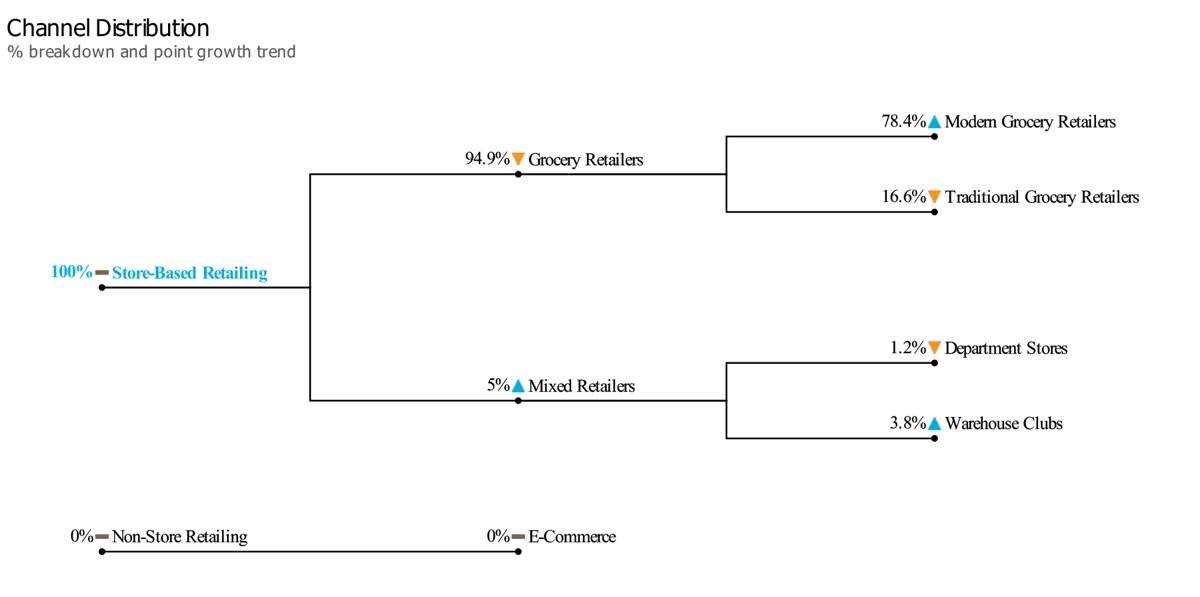
Note: The chart here showcases the off-trade volume share of different channel sales for alcoholic drink products in South Korea in 2020. The triangle/dash represents whether the specific channel share has increased/decreased or remained the same against its share in the previous year.
- Market Insights
-
Market trends
- The outbreak of COVID-19 had a wide-reaching impact on sales of alcoholic drinks in South Korea, where there was a sizeable shift from drinking through the on-trade to drinking at home. Convenience stores remained one of the most dynamic distribution channels in 2020. These stores remained open during the lockdown and benefited from their proximity to consumers’ homes. Domestic lager remained the largest category of alcoholic drinks in South Korea in 2020 partly due to its relatively low ABV (alcohol by volume) and affordable pricing. In contrast, spirits were one of the hardest-hit areas of alcoholic drinks because of their strong reliance on on-trade sales.
- Beer registered a polarised performance following the outbreak of COVID-19, with on-trade sales plummeting while off-trade sales recorded increased demand. Domestic beer brands reported a good performance largely due to the change in the liquor tax system and the declining popularity of imported beer.The net effect of the new tax system was a reduction in costs for local producers, thereby making their products more affordable and thus more attractive. Premium local beer brands filled the space left by imported beer, selling particularly well at convenience stores.
- The market for whiskies in 2020 was particularly hard hit as night-time activities were put on hold and nightclubs were forced to close. In this category, the demand for home drinking is not especially high because it is not a category of spirits that is frequently enjoyed in South Korea. Despite this, without the option of selling drinks through the on-trade, several players within whiskies started focusing on expanding their distribution network into more retail channels.
Prospects and growth opportunity
- COVID-19 has caused consumers to reflect on their lifestyle choices and how they impact their health, and this is expected to support the shift towards alcoholic drinks with lower alcohol content. There have already been new product developments across key areas such as beer and shochu/soju, with players introducing products with lower alcohol content, which is expected to continue across the forecast period. Having proved popular in other markets, there could also be room for the entry of non-alcoholic spirits, with younger adults showing an appetite for products that are more focused on the flavour than the alcohol content.
- Off-trade volume sales of shochu/soju should remain relatively resilient owing to the growing trend for drinking at home and the entry of new low ABV (alcohol by volumes) products. Players may also focus on suggesting new variants to enjoy shochu/soju by reducing its bitter flavour. DIY cocktail shochu/soju variations have become a trend among younger consumers.
General industry trends
- The South Korean government has revised the regulation for alcoholic drinks distribution and hyperlocal sales. The only caveat being that the food delivery amount is larger than the alcoholic drinks order. This is likely to see PET bottles of shochu/soju become a more popular option as the existing glass bottles are likely to be heavy and dangerous for deliveries.
- The drinking culture in South Korea has changed since the outbreak of COVID-19. There is less focus on the social aspect and more on the pleasure and enjoyment of consuming alcoholic drinks. Consumers have learned that drinking alone at home can be rather pleasant, allowing them to enjoy various flavour experiences at a lower cost than drinking through the on-trade. Trade experts believe that consumers will increasingly shift away from the heavy drinking culture and will increasingly focus on quality over quantity, which could support premiumisation across the industry.
Health & Wellness Packaged Food & Beverages
- Market size and growth
-
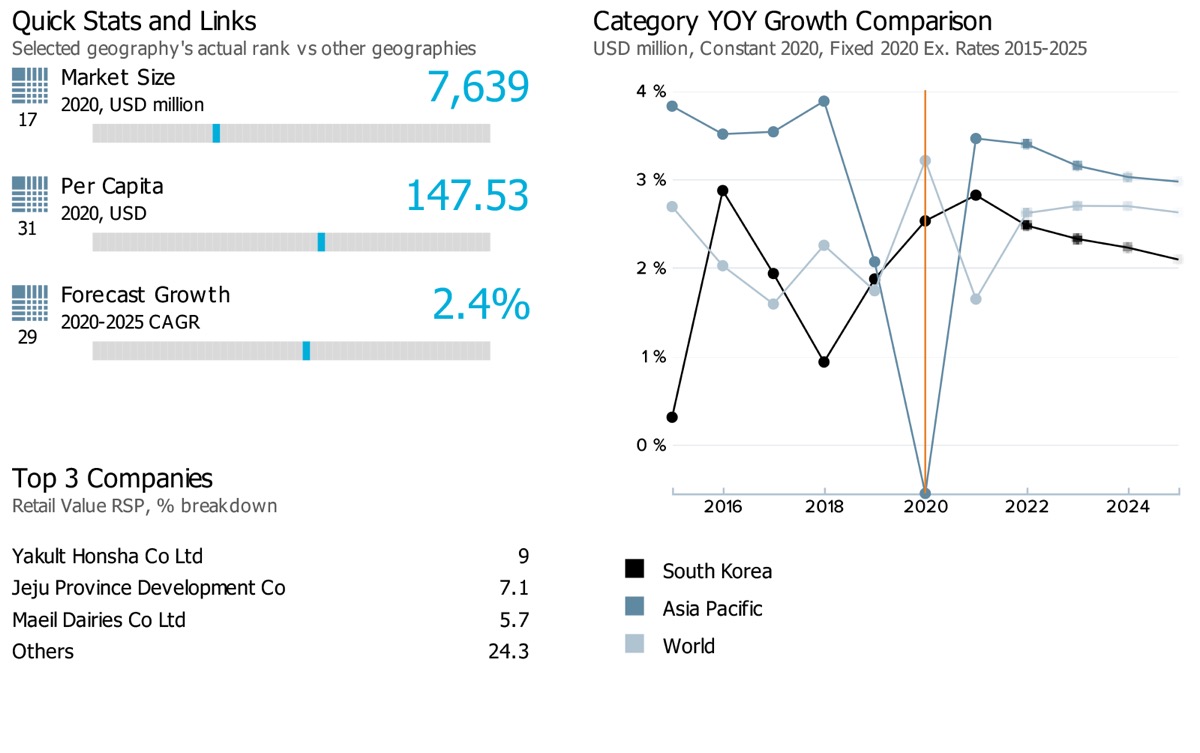
Note: Data on the top left corner of the image (17, 31, and 29) showcases respective ranks for South Korea for its market size, per capita, and forecast growth rate compared against 53 countries globally. The blue line on the grey bar represents the relative position of the country as per their rank.
The retail value sales of health and wellness food and beverage products in South Korea is expected to slow down when comparing the compound annual growth rates from historic to forecast periods, i.e. (3.2% during 2015-2020 to 2.4% during 2020-2025). This was also the case with the category’s performance at the global level, where its compound annual growth rate for retail value sales is estimated to slow down from 4.6% during 2015-2020 to 2.4% during 2020-2025.
- Sub-category breakdown
-
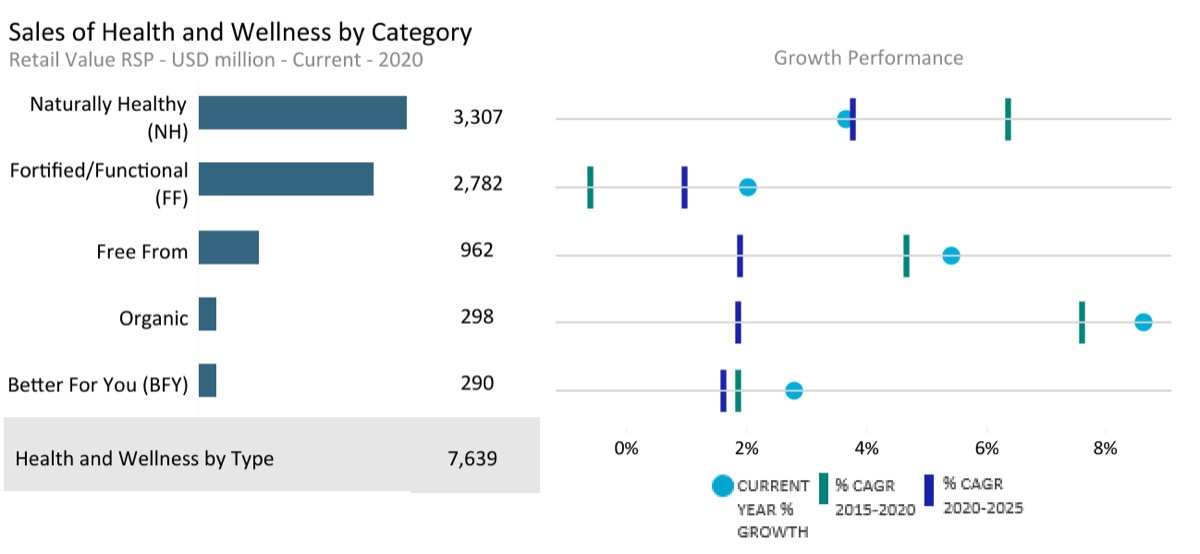
Current year growth in the above chart refers to the period 2019-20
Category
Unit
Market size (2020)
Retail value RSP
Forecast compound annual growth rate (2020/2025) %
Health and Wellness by Type
USD million
7,639.03
2.38
Better For You (BFY)
USD million
289.83
1.61
Fortified/Functional (FF)
USD million
2,781.89
0.96
Free From
USD million
961.77
1.89
Naturally Healthy (NH)
USD million
3,307.08
3.76
Organic
USD million
298.47
1.86
- Channel distribution
-
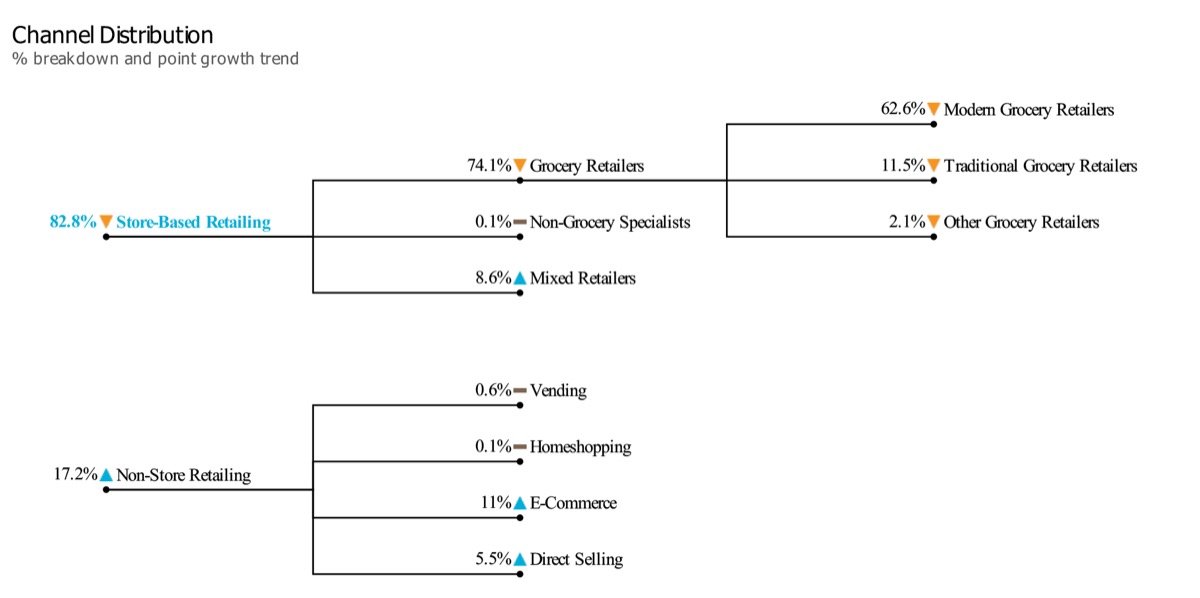
Note: The chart here showcases the retail value share of different channel sales for health and wellness by type products in South Korea in 2020. The triangle/dash represents whether the specific channel share has increased/decreased or remained the same against its share in the previous year.
- Market Insights
-
Market trends
- The COVID-19 pandemic led to rising sales for specific health and wellness products in 2020, with more consumers prioritising products claiming healthy features. Consumers have shifted to low-sugar or low-carbohydrate products to cut down the calories they consume. Meanwhile, most health and wellness food and beverage categories under review have witnessed stable supplies in traditional and e-commerce shopping channels during the pandemic. Logistics have remained stable, and deliveries were made on time. There was no sign of panic-buying nor drastic price changes for health and wellness food and beverages in South Korea.
- In South Korea, fortified/functional beverages sales declined in 2020, mainly due to the poor performance of fortified/functional sports drinks and fruit/vegetable juice. Ffortified/functional sports drinks have lost ground as a hydration recharge drink. The category has suffered from increasing competition from NH (naturally healthy) bottled water and RTD (ready to drink) tea, often claimed as healthier options, taking advantage of reduced sugar and calories.
- Sales of naturally healthy beverages have continued to increase in 2020, considering the impact of COVID-19. Apart from the small category of naturally healthy Asian speciality drinks, naturally healthy bottled water and naturally healthy RTD tea have seen the strongest growth within naturally healthy beverages. Tightening budgets have negatively affected sales of naturally healthy fruit/vegetable juice, the unit price of which is higher than the average in soft drinks.
Prospects and growth opportunity
- After the decline in sales of fortified/functional beverages in 2020, growth is expected to rebound in 2021 quickly. Whilst growth in fortified/functional fruit/vegetable juice is expected to be slow, fortified/functional sports drinks will enjoy consistent strong demand in the coming years. Many South Korean consumers have learned that the high caffeine content of energy drinks works as an instant stress reliever. Fortified/functional energy drinks are expected to continue to capture this habitual demand from consumers who want to feel better at a low cost.
- Over the coming years, a spike in demand for naturally healthy beverages can be expected, mainly in line with the growing demand for healthy hydration. Categories such as NH (naturally healthy) bottled water and NH RTD tea are set to gain further traction, especially reaching out to busy consumers. Brand owners could focus on attributes such as immune system support and hydration recharge, which are likely to be the key growth drivers over the forecast period to 2025.
General health & wellness trends
- South Koreans may reassess the purpose of food and beverages, and healthy lifestyles will be the priority. Reduced calorie products will continue to record healthy growth in the coming years, appealing well to consumers who seek weight management. There will also be an opportunity for reduced-salt products since there are increasing concerns about sodium consumption among children.
- In South Korea, the functional food and beverages category is under-developed due to strict marketing regulations. Unless the product is certified as a functional food by the Ministry of Food and Drug Safety, it only can state the list of ingredients, but not health benefits. This might be an opportunity for NH (naturally healthy) Asian speciality drinks as consumers already know how those traditional herbs work owing to the long history of medical use of herbs in the country. Ingredients such as ginseng and red ginseng, which are known as classic herbal remedies to restore energy, will help drive the category's growth.
Retail Landscape
- Brand shares of supermarkets
-
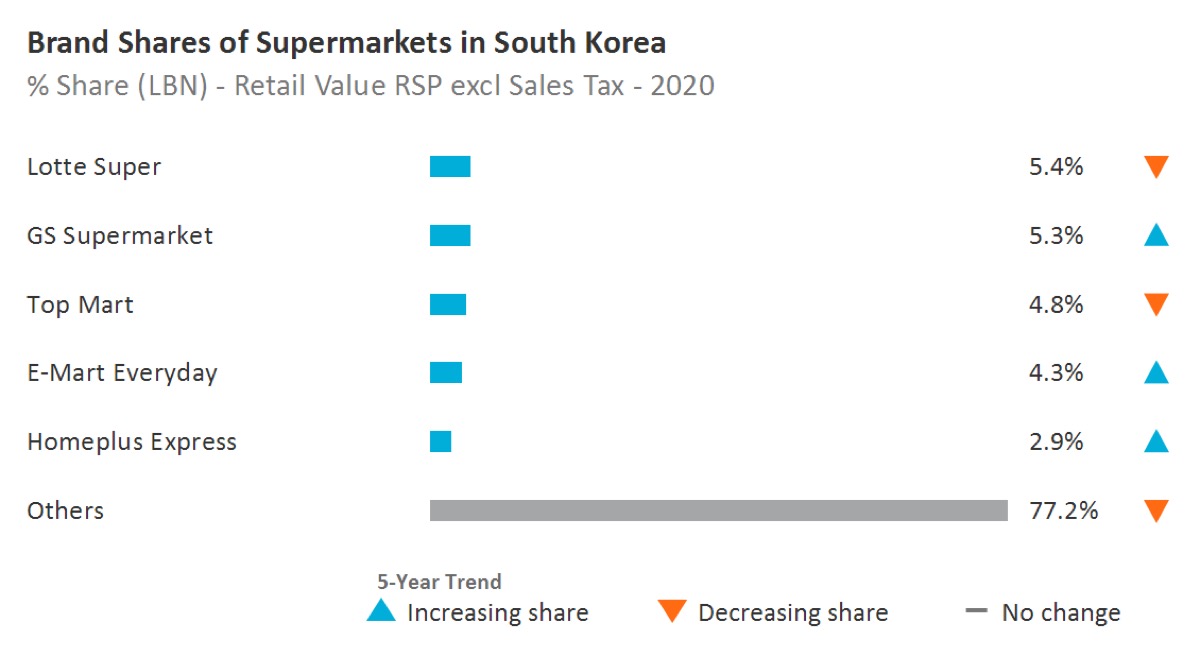
- Brand shares of chemists/pharmacies
-
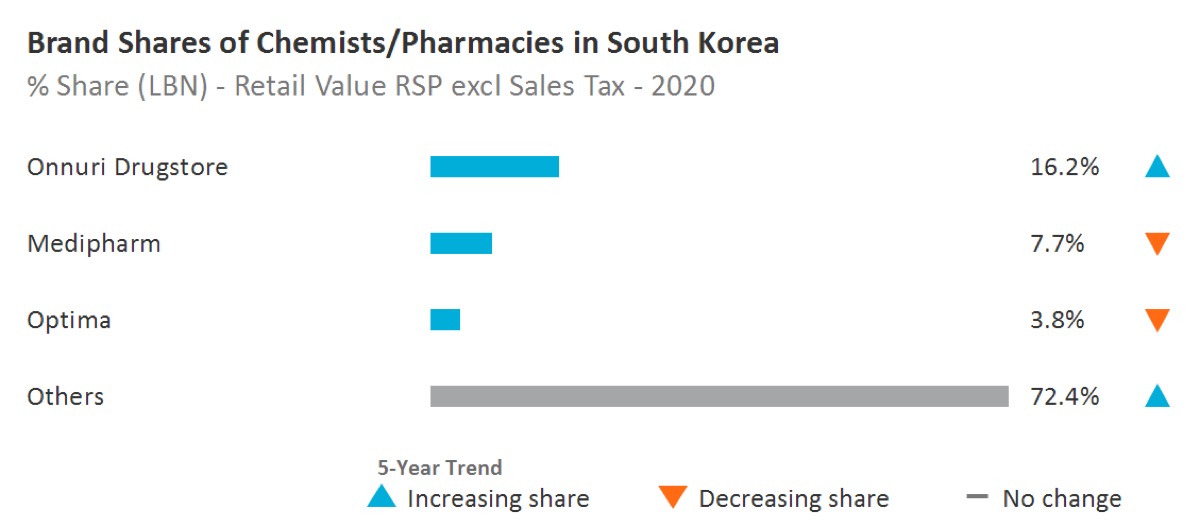
- Retail insights
-
- Unlike the hypermarket channel, which experienced a challenging 2020, supermarkets fared relatively well during the first two quarters of the year. South Koreans chose to shop for their groceries close to their neighbourhoods because of the limitation on outdoor activities. Such consumer habit changes positively affected the sales of supermarkets, as the outlets are typically located closer to residential areas.
- The growth of supermarkets has been slowing over the past few years as players failed to differentiate themselves from other store-based grocery retailers. However, their presence in residential areas and wide range of fresh food has become a unique positioning for supermarkets, contributing to the sustained growth of the channel. Nonetheless, as the reliance on online channels increases, the size of the supermarkets channel is set to show a downward trend.
- To counter the growing share of online purchases, supermarkets enhanced their digital presence by expanding their online malls or partnering with e-commerce players. In the forecast period to 2025, it is expected that more supermarket outlets will function as fulfilment centres, especially because of the channel’s strength in fresh food. In addition, there is much potential for the growth of hyperlocal delivery services over the forecast period, as fast delivery and contact-free shopping have become the norm among South Korean consumers. Supermarket players might see this as an burgeoning opportunity to scale up their logistics and delivery support to the customers.
- The country's chemist/pharmacies market was valued at USD 11,221.6 million in 2020 (Retail value RSP without sales tax). In 2020-2021, the channel's year-over-year decline rate was -7.4%. The value compound annual growth rate has been 5.4% over the last five years (2015-2020). However, the channel's retail value compound annual growth rate is expected to fall to -0.6% over the forecast period (2020-2025).
- Definitions
- Acronyms Used & Key Notes
Definitions
|
Industry |
Category |
Definition |
|---|---|---|
|
Alcoholic Drinks |
Alcoholic Drinks |
Alcoholic drinks are the aggregation of beer, wine, spirits, cider/perry and RTDs. |
|
Alcoholic Drinks |
Beer |
An alcoholic drink usually brewed from malt, sugar, hops and water and fermented with yeast. Some beers are made by fermenting a cereal, especially barley, and therefore not flavoured by hops. Alcohol content for beer is varied – anything up to and over 14% ABV (alcohol by volume), although 3.5% to 5% is most common. Beer is the aggregation of lager, dark beer, stout and non/low alcohol beer. |
|
Alcoholic Drinks |
Cider/Perry |
Cider is made from fermented apple juice while perry is made from fermented pear juice. Both artisanal and industrial cider/perry are included. |
|
Alcoholic Drinks |
RTDs |
RTD stands for ‘ready-to-drink’. Other terms which may be used for these products are FABs, alcopops and premixes. The RTDs sector is the aggregation of malt-, wine-, spirit- and other types of premixed drinks. These drinks usually have an alcohol content of around 5% but this can reach as high as 10% ABV. Premixes containing a high percentage of alcohol of around 15%+ combined with juice or any other soft drink are included here. RTDs are usually marketed as products to be drunk neat, with ice, or as a cocktail ingredient. Fruit-flavoured, vodka-based spirits with an alcohol content of between 16-21% are classified here. Examples: Alizé, Ursus Roter, Berentzen Fruchtige, Kleiner Feigling. |
|
Alcoholic Drinks |
Spirits |
This is the aggregation of whisk(e)y, brandy and Cognac, white spirits, rum, tequila, liqueurs and other spirits. |
|
Alcoholic Drinks |
Wine |
This is the aggregation of still and sparkling light grape wines, fortified wine and vermouth and non-grape wine. In terms of alcohol content, light wine usually falls into the 8-14% ABV bracket while fortified wine ranges from 14-23% ABV. Low and non-alcoholic wine is also included in the data (attributed to each sector as appropriate). |
|
Beauty and Personal Care |
Skin Care |
This is the aggregation of facial care, body care, hand care and skin care sets/kits. |
|
Beauty and Personal Care |
Body Care |
This is the aggregation of firming/anti-cellulite products and general-purpose body care. |
|
Beauty and Personal Care |
Facial Care |
This is the aggregation of acne treatments, moisturisers and treatments, facial cleansers, toners, face masks, and lip care. Please note that Moisturisers and Treatments is the aggregation of basic moisturisers and anti-agers. |
|
Beauty and Personal Care |
Hand Care |
Includes all hand moisturisers, both premium and mass market, as well as combination hand and nail products. Includes protective emollients and deep moisturisers formulated to sooth and hydrate very dry or irritated skin, as well as those that prevent, or that are suitable for, eczema-prone or redness-prone skin. Excludes medicated emollients and/or those positioned as treatment for eczema or psoriasis. |
|
Beauty and Personal Care |
Skin Care Sets/Kits |
Multiple skin care items of the same brand line packaged together in a set and priced at an advantageous price compared to purchasing the items separately. Includes traditional gift sets, multi-step skin care regimens, skin care starter kits (including acne treatment regimen sets/kits) and skin care travel kits (sold through retail outlets). Also includes sets, which comprise of products from multiple categories (e.g. makeup and skin care), as long as the primary product is skin care. Men’s, women’s and unisex versions are included. Excludes: GWP (Gift with Purchase) – consumer does not pay for this (e.g. free product when you purchase a set or a free sample kit). |
|
Consumer Health |
Dietary Supplements |
It is the aggregation of all dietary supplements: Minerals, fish oils/omega fatty acids, garlic, ginseng, ginkgo biloba, evening primrose oil, Echinacea, St John's Wort, protein supplements, probiotic supplements, eye health supplements, co-enzyme Q10, glucosamine, combination herbal/traditional supplements, non-herbal/traditional supplements, and all other dietary supplements specific to country coverage. |
|
Consumer Health |
Paediatric Vitamins and Dietary Supplements |
All vitamin and dietary supplement products formulated, designed, marketed and labelled specifically for children. |
|
Consumer Health |
Tonics |
Include versions of combination dietary supplements that are sold in the format of liquid concentrates, mini-drinks, shots or oral gels. Include concentrated energy shot boosters and tonics such as 5-Hour Energy and Lipovitan. Exclude remedies made with active pharmaceutical ingredients as well as super fruit juice concentrates and weight-loss beverages, tracked under the Health and Wellness (HW) system. |
|
Consumer Health |
Vitamins |
This is the aggregation of multivitamins and single vitamins. |
|
Health and Wellness |
Health and Wellness by Type |
Health and Wellness by Type is the aggregation of all health and wellness food and beverages broken down by organic, fortified/functional, naturally healthy, better for you and free from products. |
|
Health and Wellness |
Better For You (BFY) |
Products where the amount of a substance considered to be less healthy (eg fat, sugar, salt, carbohydrates) has been actively reduced during production. To qualify for inclusion in this category, the “less healthy” element of the foodstuff needs to have been actively removed or substituted during the processing. This should also form a key part of the positioning/marketing of the product. Products which are naturally fat/sugar/carbohydrate -free are not included as nothing out of the ordinary has been done during their production to make them “better for you”. “No added sugar” claims are excluded too. Products most likely to be included here will be those which are low-fat/low-sugar versions of standard products (i.e. reduced fat mayonnaise, reduced fat cheese, reduced fat milk, reduced sugar confectionery, etc). |
|
Health and Wellness |
Fortified/Functional (FF) |
This category includes fortified/functional food and beverages. When identifying fortified/functional products, we focus on products to which health ingredients or/and nutrients have been added as well as brands that are positioned to deliver a certain functionality. To be included here the enhancement must be highlighted in the label or hold a health claim/nutritional claim. Fortified/functional food and beverages provide health benefits beyond their nutritional value and/or the level of added ingredients wouldn’t normally be found in that product. To merit inclusion in this category, the defining criterion here is that the product must have been actively fortified/enhanced during production. As such, inherently healthy products such as 100% fruit/vegetable juices are only included under "fortified/functional" if additional health ingredients (e.g. calcium, omega 3) have been added. To be included, the health benefit needs to form part of positioning/marketing of the product. For product category definitions please refer to the definitions section (can be found under the "Help" section on Passport) for the respective system: Packaged Food, Hot Drinks, Soft Drinks. |
|
Health and Wellness |
Free From |
This category includes free from gluten, free from lactose, free from allergens, free from dairy and free from meat products. This excludes foods which are certified ‘free’ of a specific product when this is based on use of sterilised equipment. |
|
Health and Wellness |
Naturally Healthy (NH) |
This category includes food and beverages based on naturally containing a substance that improves health and wellbeing beyond the product’s pure calorific value. These products are usually a healthier alternative within a certain sector/subsector. High fibre food (wholegrain/wholemeal/brown), soy products, sour milk drinks, nuts, seeds and trail mixes, honey, fruit and nut bars and olive oil are considered NH foods and 100% fruit/vegetable juice, superfruit juice, natural mineral water, spring water, RTD green tea etc. are considered NH beverages. While many of these products are marketed on a health basis, this might not always be the case. Naturally healthy food and beverages that are additionally fortified fall into the 'fortified/functional' category. |
|
Health and Wellness |
Organic |
Certified organic products are those which have been produced, stored, processed, handled and marketed in accordance with precise technical specifications (standards) and certified as "organic" by a certification body such as the Soil Association in the UK, the European Union or the US Department of Agriculture. It is important to note that an organic label applies to the production process, ensuring that the product has been produced and processed in an ecologically sound manner. The organic label is therefore a production process claim as opposed to a product quality claim. Note: For organic products to be included, the organic aspect needs to form a significant part of the overall positioning/marketing of the product, including the organic certification label in the packaging. |
|
Pet Care |
Dog and Cat Food |
This is the aggregation of dog and cat food. |
|
Pet Care |
Cat Food |
This is the aggregation of wet and dry cat food. |
|
Pet Care |
Cat Treats and Mixers |
This is the aggregation of mixers and treats for cats. |
|
Pet Care |
Dry Cat Food |
These products have a moisture content of 10-14% and are generally packed into paper, plastic or cardboard. Dry cat food is typically made from a combination of grain-based ingredients (corn and rice) and a meat component. It is typically produced by extrusion cooking under high heat and pressure and then sprayed with fat to increase palatability. Other ingredients may also be added to complete its composition. This is the aggregation of premium, mid-priced and economy dry cat food. Note: semi-moist food is included here. These products are extruded (combining meat and cereal), have a higher moisture content (20-40%) and are usually packaged in plastic or foil sachets. |
|
Pet Care |
Wet Cat Food |
These products have a moisture content of 60-85% and are generally (though not always) preserved by heat treatment. They are packaged in steel or aluminium cans, rigid or flexible plastic or semi-rigid aluminium trays. This is the aggregation of premium, mid-priced and economy wet cat food. |
|
Pet Care |
Dog Food |
This is the aggregation of wet and dry dog food. |
|
Pet Care |
Dog Treats and Mixers |
This is the aggregation of mixers and treats for dogs. |
|
Pet Care |
Dry Dog Food |
These products generally have a moisture content of 6-14% and are generally packed into paper, plastic or cardboard. Complete dry dog foods fall into two broad categories: Flaked (or 'Muesli' type blended products) and Extruded products (meat and cereals cooked by direct steaming). This is the aggregation of premium, mid-priced and economy dry dog food. Note: semi-moist food is included here. These products are extruded (combining meat and cereal) have a higher moisture content (20-40%) and are usually packaged in plastic or foil sachets. |
|
Pet Care |
Wet Dog Food |
These products have a moisture content of 60-85% and are generally (though not always) preserved by heat treatment. They are packaged in steel or aluminium cans, rigid or flexible plastic or semi-rigid aluminium trays. This is the aggregation of premium, mid-priced and economy wet dog food. |
|
Retail in Alcoholic Drinks |
Store-Based Retailing |
Store-based retailing is the aggregation of grocery retailers and non-grocery specialists and mixed retailers. |
|
Retail in Alcoholic Drinks |
Grocery Retailers |
Retailers selling predominantly food/beverages/tobacco and other everyday groceries. This is the aggregation of hypermarkets, supermarkets, discounters, convenience stores, independent small grocers, forecourt retailers, food/drink/tobacco specialists and other grocery retailers. |
|
Retail in Alcoholic Drinks |
Convenience Stores |
Chained grocery retail outlets selling a wide range of groceries and fitting several of the following characteristics: Extended opening hours •Selling area of less than 400 sq. metres •Located in residential neighbourhoods •Handling two or more of the following product categories: audio-visual goods (for sale or rent), foodservice (prepared take-away, made-to-order, and hot foods), newspapers or magazines, cut flowers or pot plants, greetings cards, automotive accessories. Example brands include 7-Eleven, Spar. |
|
Retail in Alcoholic Drinks |
Discounters |
Discounters are retail outlets typically with a selling space of between 400 and 2,500 square metres. Retailers' primary focus is on selling private label products within a limited range of food/beverages/tobacco and other groceries at budget prices. Discounters may also sell a selection of non-groceries, frequently as short-term special offers. Discounters can be classified as hard discounters and soft discounters. Hard discounter: first introduced by Aldi in Germany, and also known as limited-line discounters. Retail outlets, typically of 300-900 square metres, stocking fewer than 1,000 product lines, largely in packaged groceries. Goods are mainly private-label or budget brands. Soft discounter: usually slightly larger than hard discounters, and also known as extended-range discounters. Retail outlets typically stocking 1,000-4,000 product lines. As well as private-label and budget brands, stores commonly carry leading brands at discounted prices. Discounters excludes mass merchandisers and warehouse clubs. Example brands include Aldi, Lidl, Plus, Penny, Netto. |
|
Retail in Alcoholic Drinks |
Forecourt Retailers |
Grocery retail outlets selling a wide range of groceries from a gas station forecourt and fitting several of the following characteristics: • Extended opening hours • Selling area of less than 400 sq. metres • Handling two or more of the following product categories: audio-visual goods (for sale or rent), take-away food (readymade sandwiches, rolls or hot food), newspapers or magazines, cut flowers or pot plants, greetings cards, automotive accessories. Example brands include BP Connect, Shell Select. Forecourt retailers includes both chained forecourt retailers and independent forecourt retailers. |
|
Retail in Alcoholic Drinks |
Hypermarkets |
Hypermarkets are retail outlets with a selling space of over 2,500 square metres and with a primary focus on selling food/beverages/tobacco and other groceries. Hypermarkets also sell a range of non-grocery merchandise. Hypermarkets are frequently located on out-of-town sites or as the anchor store in a shopping centre. Example brands include Carrefour, Tesco Extra, Géant, E Leclerc, Intermarché, Auchan. Excludes cash and carry, warehouse clubs and mass merchandisers. |
|
Retail in Alcoholic Drinks |
Supermarkets |
Retail outlets selling groceries with a selling space of between 400 and 2,500 square metres. Excludes discounters, convenience stores and independent grocery stores. Example brands include Champion, Tesco, Casino. |
|
Retail in Alcoholic Drinks |
Food/drink/tobacco specialists |
Retail outlets specialising in the sale of mainly one category of food, drinks store and tobacconists. Includes bakers (bread and flour confectionery), butchers (meat and meat products), fishmongers (fish and seafood), greengrocers (fruit and vegetables), drinks stores (alcoholic and non-alcoholic drinks), tobacconists (tobacco products and smokers’ accessories), cheesemongers, chocolatiers and other single food categories. Alcoholic drinks stores are retail outlets with a primary focus on selling beer/wine/spirits/other alcoholic beverages. Example brands include: Threshers, Gall & Gall, Liquorland, Watson’s Wine Cellar |
|
Retail in Alcoholic Drinks |
Independent Small Grocers |
Retail outlets selling a wide range of predominantly grocery products. These outlets are usually not chained and if chained will have fewer than 10 retail outlets. Mainly family owned, often referred to as Mom and Pop stores. |
|
Retail in Alcoholic Drinks |
Other Grocery Retailers |
Other retailers selling predominantly food, beverages and tobacco or a combination of these. Includes kiosks, markets selling predominantly groceries. Includes CTNs and health food stores, Food & drink souvenir stores and regional speciality stores. Direct home delivery, eg of milk, meat from farm/dairy is excluded. Sari-Sari stores in Philippines and Warung (Waroon) in Indonesia, that can either be markets or kiosks, are included in Other grocery retailers unless they occupy a separate permanent outlet building, in which case they are included in Independent small grocers. Outlets located within wet markets, particularly in South East Asia (often located in government-owned multi-story buildings) should be counted as separate outlets. Wine sales from Vineyards are included here. |
|
Retail in Alcoholic Drinks |
Non-Grocery Specialists |
Retail outlets selling predominantly non-grocery consumer goods. Non-grocery retailers is the aggregation of: • Apparel and footwear specialist retailers • Electronics and appliance specialist retailers • Health & beauty specialist retailers • Home and garden specialist retailers • Leisure and personal goods specialist retailers • Other non-grocery retailers |
|
Retail in Alcoholic Drinks |
Drugstores/parapharmacies |
Retail outlets selling mainly OTC healthcare, cosmetics and toiletries, disposable paper products, household care products and other general merchandise. Such outlets may also offer prescription-bound medicines under the supervision of a pharmacist. Drugstores in Spain (Droguerias) also sell household cleaning agents, paint, DIY products and sometimes pet products and services such as photo processing. Example brands include Rossmann (Germany), Kruidvat (Netherlands), Walgreen’s (US), CVS (US), Medicine Shoppe (US), Matsumoto Kiyoshi (Japan), HAC Kimisawa (Japan). |
|
Retail in Alcoholic Drinks |
Mixed Retailers |
This is the aggregation of department stores, variety stores, mass merchandisers and warehouse clubs. |
|
Retail in Alcoholic Drinks |
Department Stores |
Outlets selling mainly non-grocery merchandise and at least five lines in different departments, usually with a sales area of over 2,500 sq metres. They are usually arranged over several floors. Example brands include Macy’s, Bloomingdale’s, Marks & Spencer, Harrods, Sears, JC Penney, Takashimaya, Mitsukoshi, Daimaru, Karstadt, Rinascente. |
|
Retail in Alcoholic Drinks |
Mass Merchandisers |
Mixed retail outlets that usually: (1) convey the image of a high-volume, fast-turnover outlet selling a variety of merchandise for less than conventional prices; (2) provide centralised check-out service; and (3) provide minimal customer assistance within each department. Example brands include Wal-Mart, Target and Kmart. Excludes hypermarkets and warehouse clubs/cash and carry stores. |
|
Retail in Alcoholic Drinks |
Variety Stores |
Non-grocery general merchandise outlets usually located on one floor, offering a wide assortment of extensively discounted fast-moving consumer goods on a self-service basis. Normally over 1,500 sq. metres in size, except in the case of dollar stores, these outlets give priority to fast-moving non-grocery items that have long shelf-lives. Includes catalogue showrooms and dollar stores. Example brands include Woolworth (Germany), Upim (Italy). |
|
Retail in Alcoholic Drinks |
Warehouse Clubs |
Warehouse Clubs are chained outlets that sell a wide variety of merchandise but do have a strong mix of both grocery and non-grocery products. Customers have to pay an annual membership fee in order to shop. The clubs are able to keep prices low due to the no-frills format of the stores and attempt to drive volume sales through aggressive pricing techniques. Warehouse Clubs typically: - exceed 2,500 sq. metres of selling space and are invariably -over 4,000 sq. metres in size; - convey the image of a high-volume, fast-turnover retailing at less than conventional prices; - provide minimal customer assistance within each department; and - are situated in out-of-town locations. Example brands include: - Costco - Sam’s Club (Wal-Mart) - PriceSmart - Cost-U-Less |
|
Retail in Alcoholic Drinks |
Non-Store Retailing |
The retail sale of new and used goods to the general public for personal or household consumption from locations other than retail outlets or market stalls. Non-store retailing is the aggregation of Vending, Direct Selling, Homeshopping and Internet Retailing. |
|
Retail in Alcoholic Drinks |
Direct Selling |
Direct selling is the marketing of consumer goods directly to consumers, generally in their homes or the homes of others, at their workplace and other places away from permanent retail locations. Direct selling occurs in two primary ways: one-to-one basis (usually by prior arrangement a demonstration is given by a direct seller to a customer) or party-plan basis (selling through explanation and demonstration of products to a group of prospective customers by a direct seller usually in the home of a host(ess) who invites other persons for this purpose). |
|
Retail in Alcoholic Drinks |
Homeshopping |
Homeshopping is the sale of consumer goods to the general public via mail order catalogues, TV shopping and direct mail. Consumers purchase goods in direct response to an advertisement or promotion through a mail item, printed catalogue, TV shopping programme, or Internet catalogue whereby the order is placed, and payment is made by phone, by post or through other media such as digital TV. Excludes sales on returned products/unpaid invoices. Excludes sales ordered and paid online which are instead included within Internet retailing. |
|
Retail in Alcoholic Drinks |
E-Commerce |
Sales of consumer goods to the general public via the Internet. Please note that this includes sales through mobile phones and tablets. Internet retailing includes sales generated through pure e-commerce web sites and through sites operated by store-based retailers. Sales data is attributed to the country where the consumer is based, rather than where the retailer is based. Also includes orders placed through the web for which payment is then made through a storecard, an online credit account subsequent to delivery or on delivery of the product. This payment may be by any mode of payment including postal cheque, direct debit, standing order or other banking tools. Includes orders paid for cash on delivery. Includes m-commerce: where consumers use smart phones or tablets to connect to Internet and purchase the goods online. |
|
Retail in Alcoholic Drinks |
Vending |
Vending means automatic retailing. It covers the sale of products and services at an unattended point of sale through a machine operated by introducing coins, bank notes, payment cards, tokens or other means of cashless payment. Coverage includes vending systems installed in public and semi-captive environments only. Hotels, transport networks, recreational centres, shopping centres/malls are included. Factories, offices, hospitals, prisons, schools and other captive environments are excluded. |
|
Retail in Beauty and Personal Care |
Store-Based Retailing |
Store-based retailing is the aggregation of grocery retailers and non-grocery specialists and mixed retailers. |
|
Retail in Beauty and Personal Care |
Grocery Retailers |
Retailers selling predominantly food/beverages/tobacco and other everyday groceries. This is the aggregation of hypermarkets, supermarkets, discounters, convenience stores, independent small grocers, forecourt retailers, food/drink/tobacco specialists and other grocery retailers. |
|
Retail in Beauty and Personal Care |
Modern Grocery Retailers |
Modern grocery retailing is the aggregation of those grocery channels that have emerged alongside the growth of chained retail: Hypermarkets, Supermarkets, Discounters, Forecourt Retailers and Convenience Stores. |
|
Retail in Beauty and Personal Care |
Convenience Stores |
Chained grocery retail outlets selling a wide range of groceries and fitting several of the following characteristics: Extended opening hours •Selling area of less than 400 sq. metres •Located in residential neighbourhoods •Handling two or more of the following product categories: audio-visual goods (for sale or rent), foodservice (prepared take-away, made-to-order, and hot foods), newspapers or magazines, cut flowers or pot plants, greetings cards, automotive accessories. Example brands include 7-Eleven, Spar. |
|
Retail in Beauty and Personal Care |
Discounters |
Discounters are retail outlets typically with a selling space of between 400 and 2,500 square metres. Retailers' primary focus is on selling private label products within a limited range of food/beverages/tobacco and other groceries at budget prices. Discounters may also sell a selection of non-groceries, frequently as short-term special offers. Discounters can be classified as hard discounters and soft discounters. Hard discounter: first introduced by Aldi in Germany, and also known as limited-line discounters. Retail outlets, typically of 300-900 square metres, stocking fewer than 1,000 product lines, largely in packaged groceries. Goods are mainly private-label or budget brands. Soft discounter: usually slightly larger than hard discounters, and also known as extended-range discounters. Retail outlets typically stocking 1,000-4,000 product lines. As well as private-label and budget brands, stores commonly carry leading brands at discounted prices. Discounters excludes mass merchandisers and warehouse clubs. Example brands include Aldi, Lidl, Plus, Penny, Netto. |
|
Retail in Beauty and Personal Care |
Forecourt Retailers |
Grocery retail outlets selling a wide range of groceries from a gas station forecourt and fitting several of the following characteristics: • Extended opening hours • Selling area of less than 400 sq. metres • Handling two or more of the following product categories: audio-visual goods (for sale or rent), take-away food (ready-made sandwiches, rolls or hot food), newspapers or magazines, cut flowers or pot plants, greetings cards, automotive accessories. Example brands include BP Connect, Shell Select. Forecourt retailers includes both chained forecourt retailers and independent forecourt retailers. |
|
Retail in Beauty and Personal Care |
Hypermarkets |
Hypermarkets are retail outlets with a selling space of over 2,500 square metres and with a primary focus on selling food/beverages/tobacco and other groceries. Hypermarkets also sell a range of non-grocery merchandise. Hypermarkets are frequently located on out-of-town sites or as the anchor store in a shopping centre. Example brands include Carrefour, Tesco Extra, Géant, E Leclerc, Intermarché, Auchan. Excludes cash and carry, warehouse clubs and mass merchandisers. |
|
Retail in Beauty and Personal Care |
Supermarkets |
Retail outlets selling groceries with a selling space of between 400 and 2,500 square metres. Excludes discounters, convenience stores and independent grocery stores. Example brands include Champion, Tesco, Casino. |
|
Retail in Beauty and Personal Care |
Traditional Grocery Retailers |
Traditional grocery retailing is the aggregation of those channels that are invariably non-chained and are, therefore, owned by families and/or run on an individual basis. Traditional grocery retailing is the aggregation of three channels: Independent Small Grocers, Food/Drink/Tobacco Specialists and Other Grocery Retailers. |
|
Retail in Beauty and Personal Care |
Non-Grocery Specialists |
Retail outlets selling predominantly non-grocery consumer goods. Non-grocery retailers is the aggregation of: • Apparel and footwear specialist retailers • Electronics and appliance specialist retailers • Health & beauty specialist retailers • Home and garden specialist retailers • Leisure and personal goods specialist retailers • Other non-grocery retailers |
|
Retail in Beauty and Personal Care |
Apparel and Footwear Specialist Retailers |
Outlets specialising in the sale of all types of apparel, footwear and fashion accessories including costume jewellery, belts, handbags, hats, scarves or a combination of these (for example stores selling handbags only are included). This includes those stores that carry a combination of all products for either men or women or children and those that may specialise by either gender, age or product. Example brands include Gap, H&M, Zara, C&A, Miss Selfridge, Foot Locker, Uniglo, Next, Matalan. Brands that offer sports apparel and sports goods are excluded from Apparel and footwear specialist retailers and are included in Sports goods stores. |
|
Retail in Beauty and Personal Care |
Electronics and Appliance Specialist Retailers |
Retail outlets specialising in the sale of large or small domestic electrical appliances, consumer electronic equipment (including mobile phones), computers or a combination of these. For mobile phone retailers, this excludes revenues derived from telecoms service plans and top-up cards, etc. Example brands include Apple, Best Buy, Euronics, PC World, Darty, But, Media Markt, Yamada Denki, Gome (China). |
|
Retail in Beauty and Personal Care |
Health and Beauty Specialist Retailers |
This is the aggregation of chemists/pharmacies, drugstores/parapharmacies, beauty specialist retailers, optical goods stores and other healthcare specialist retailers. |
|
Retail in Beauty and Personal Care |
Beauty Specialist Retailers |
Beauty specialist retailers are chained or independent retail outlets with a primary focus on selling fragrances, other cosmetics and toiletries, beauty accessories or a combination of these. Examples of Beauty specialist retailer brands include: Body Shop, Marionnaud, Sephora and Bath and Body Works. |
|
Retail in Beauty and Personal Care |
Chemists/Pharmacies |
Retail outlets selling prescription-bound medicines under the supervision of a pharmacist and as its core activity (other activities include sales of OTC healthcare and cosmetics and toiletries products). |
|
Retail in Beauty and Personal Care |
Drugstores/parapharmacies |
Retail outlets selling mainly OTC healthcare, cosmetics and toiletries, disposable paper products, household care products and other general merchandise. Such outlets may also offer prescription-bound medicines under the supervision of a pharmacist. Drugstores in Spain (Droguerias) also sell household cleaning agents, paint, DIY products and sometimes pet products and services such as photo processing. Example brands include Rossmann (Germany), Kruidvat (Netherlands), Walgreen’s (US), CVS (US), Medicine Shoppe (US), Matsumoto Kiyoshi (Japan), HAC Kimisawa (Japan). |
|
Retail in Beauty and Personal Care |
Home and Garden Specialist Retailers |
This is the aggregation of homewares and home furnishing stores and home improvement and gardening stores. Business-to-business sales are excluded. Home improvement and gardening stores are chained or independent retail outlets with a primary focus on selling one or more of the following categories: Home improvement materials and hardware, Paints, coatings and wall coverings, Kitchen and bathroom, fixtures and fittings, Gardening equipment, House/Garden plants. Home improvement and gardening stores includes Home improvement centres / DIY stores, Hardware stores (Ironmongers), Garden centres, Kitchen and bathroom showrooms, Tile specialists, Flooring specialists. Homewares and Home Furnishing stores are retail outlets specialising in the sale of home furniture and furnishings, homewares, floor coverings, soft furnishings, lighting etc. |
|
Retail in Beauty and Personal Care |
Homewares and Home Furnishing Stores |
Retail outlets specialising in the sale of home furniture and furnishings, homewares, floor coverings, soft furnishings, lighting etc. |
|
Retail in Beauty and Personal Care |
Other Non-Grocery Specialists |
Other non-grocery retailers are chained or independent retail outlets, kiosks, market stalls or street vendors and with a primary focus on selling non-food merchandise. Other non-grocery retailers include Charity shops, Second-hand shops and Market stalls. |
|
Retail in Beauty and Personal Care |
Outdoor Markets |
Includes bazaars, kiosks, street vendors and beach vendors. |
|
Retail in Beauty and Personal Care |
Mixed Retailers |
This is the aggregation of department stores, variety stores, mass merchandisers and warehouse clubs. |
|
Retail in Beauty and Personal Care |
Department Stores |
Outlets selling mainly non-grocery merchandise and at least five lines in different departments, usually with a sales area of over 2,500 sq metres. They are usually arranged over several floors. Example brands include Macy’s, Bloomingdale’s, Marks & Spencer, Harrods, Sears, JC Penney, Takashimaya, Mitsukoshi, Daimaru, Karstadt, Rinascente. |
|
Retail in Beauty and Personal Care |
Mass Merchandisers |
Mixed retail outlets that usually: (1) convey the image of a high-volume, fast-turnover outlet selling a variety of merchandise for less than conventional prices; (2) provide centralised check-out service; and (3) provide minimal customer assistance within each department. Example brands include Wal-Mart, Target and Kmart. Excludes hypermarkets and warehouse clubs/cash and carry stores. |
|
Retail in Beauty and Personal Care |
Variety Stores |
Non-grocery general merchandise outlets usually located on one floor, offering a wide assortment of extensively discounted fast-moving consumer goods on a self-service basis. Normally over 1,500 sq. metres in size, except in the case of dollar stores, these outlets give priority to fast-moving non-grocery items that have long shelf-lives. Includes catalogue showrooms and dollar stores. Example brands include Woolworth (Germany), Upim (Italy). |
|
Retail in Beauty and Personal Care |
Warehouse Clubs |
Warehouse Clubs are chained outlets that sell a wide variety of merchandise but do have a strong mix of both grocery and non-grocery products. Customers have to pay an annual membership fee in order to shop. The clubs are able to keep prices low due to the no-frills format of the stores and attempt to drive volume sales through aggressive pricing techniques. Warehouse Clubs typically: - exceed 2,500 sq. metres of selling space and are invariably -over 4,000 sq. metres in size; - convey the image of a high-volume, fast-turnover retailing at less than conventional prices; - provide minimal customer assistance within each department; and - are situated in out-of-town locations. Example brands include: - Costco - Sam’s Club (Wal-Mart) - PriceSmart - Cost-U-Less |
|
Retail in Beauty and Personal Care |
Non-Store Retailing |
The retail sale of new and used goods to the general public for personal or household consumption from locations other than retail outlets or market stalls. Non-store retailing is the aggregation of Vending, Direct Selling, Homeshopping and Internet Retailing. |
|
Retail in Beauty and Personal Care |
Direct Selling |
Direct selling is the marketing of consumer goods directly to consumers, generally in their homes or the homes of others, at their workplace and other places away from permanent retail locations. Direct selling occurs in two primary ways: one-to-one basis (usually by prior arrangement a demonstration is given by a direct seller to a customer) or party-plan basis (selling through explanation and demonstration of products to a group of prospective customers by a direct seller usually in the home of a host(ess) who invites other persons for this purpose). |
|
Retail in Beauty and Personal Care |
Homeshopping |
Homeshopping is the sale of consumer goods to the general public via mail order catalogues, TV shopping and direct mail. Consumers purchase goods in direct response to an advertisement or promotion through a mail item, printed catalogue, TV shopping programme, or Internet catalogue whereby the order is placed, and payment is made by phone, by post or through other media such as digital TV. Excludes sales on returned products/unpaid invoices. Excludes sales ordered and paid online which are instead included within Internet retailing. |
|
Retail in Beauty and Personal Care |
E-Commerce |
Sales of consumer goods to the general public via the Internet. Please note that this includes sales through mobile phones and tablets. Internet retailing includes sales generated through pure e-commerce web sites and through sites operated by store-based retailers. Sales data is attributed to the country where the consumer is based, rather than where the retailer is based. Also includes orders placed through the web for which payment is then made through a storecard, an online credit account subsequent to delivery or on delivery of the product. This payment may be by any mode of payment including postal cheque, direct debit, standing order or other banking tools. Includes orders paid for cash on delivery. Includes m-commerce: where consumers use smart phones or tablets to connect to Internet and purchase the goods online. |
|
Retail in Beauty and Personal Care |
Vending |
Vending means automatic retailing. It covers the sale of products and services at an unattended point of sale through a machine operated by introducing coins, bank notes, payment cards, tokens or other means of cashless payment. Coverage includes vending systems installed in public and semi-captive environments only. Hotels, transport networks, recreational centres, shopping centres/malls are included. Factories, offices, hospitals, prisons, schools and other captive environments are excluded. |
|
Retail in Beauty and Personal Care |
Hair Salons |
Hair salons |
|
Retail in Health and Wellness |
Store-Based Retailing |
Store-based retailing is the aggregation of grocery retailers and non-grocery specialists and mixed retailers. |
|
Retail in Health and Wellness |
Convenience Stores |
Chained grocery retail outlets selling a wide range of groceries and fitting several of the following characteristics: Extended opening hours •Selling area of less than 400 sq. metres •Located in residential neighbourhoods •Handling two or more of the following product categories: audio-visual goods (for sale or rent), foodservice (prepared take-away, made-to-order, and hot foods), newspapers or magazines, cut flowers or pot plants, greetings cards, automotive accessories. Example brands include 7-Eleven, Spar. |
|
Retail in Health and Wellness |
Discounters |
Discounters are retail outlets typically with a selling space of between 400 and 2,500 square metres. Retailers' primary focus is on selling private label products within a limited range of food/beverages/tobacco and other groceries at budget prices. Discounters may also sell a selection of non-groceries, frequently as short-term special offers. Discounters can be classified as hard discounters and soft discounters. Hard discounter: first introduced by Aldi in Germany, and also known as limited-line discounters. Retail outlets, typically of 300-900 square metres, stocking fewer than 1,000 product lines, largely in packaged groceries. Goods are mainly private-label or budget brands. Soft discounter: usually slightly larger than hard discounters, and also known as extended-range discounters. Retail outlets typically stocking 1,000-4,000 product lines. As well as private-label and budget brands, stores commonly carry leading brands at discounted prices. Discounters excludes mass merchandisers and warehouse clubs. Example brands include Aldi, Lidl, Plus, Penny, Netto. |
|
Retail in Health and Wellness |
Forecourt Retailers |
Grocery retail outlets selling a wide range of groceries from a gas station forecourt and fitting several of the following characteristics: • Extended opening hours • Selling area of less than 400 sq. metres • Handling two or more of the following product categories: audio-visual goods (for sale or rent), take-away food (ready made sandwiches, rolls or hot food), newspapers or magazines, cut flowers or pot plants, greetings cards, automotive accessories. Example brands include BP Connect, Shell Select. Forecourt retailers includes both chained forecourt retailers and independent forecourt retailers. |
|
Retail in Health and Wellness |
Hypermarkets |
Hypermarkets are retail outlets with a selling space of over 2,500 square metres and with a primary focus on selling food/beverages/tobacco and other groceries. Hypermarkets also sell a range of non-grocery merchandise. Hypermarkets are frequently located on out-of-town sites or as the anchor store in a shopping centre. Example brands include Carrefour, Tesco Extra, Géant, E Leclerc, Intermarché, Auchan. Excludes cash and carry, warehouse clubs and mass merchandisers. |
|
Retail in Health and Wellness |
Supermarkets |
Retail outlets selling groceries with a selling space of between 400 and 2,500 square metres. Excludes discounters, convenience stores and independent grocery stores. Example brands include Champion, Tesco, Casino. |
|
Retail in Health and Wellness |
Independent Small Grocers |
Retail outlets selling a wide range of predominantly grocery products. These outlets are usually not chained and if chained will have fewer than 10 retail outlets. Mainly family owned, often referred to as Mom and Pop stores. |
|
Retail in Health and Wellness |
Other Grocery Retailers |
Other retailers selling predominantly food, beverages and tobacco or a combination of these. Includes kiosks, markets selling predominantly groceries. Includes CTNs and health food stores, Food & drink souvenir stores and regional speciality stores. Direct home delivery, e.g. of milk, meat from farm/dairy is excluded. Sari-Sari stores in Philippines and Warung (Waroon) in Indonesia, that can either be markets or kiosks, are included in Other grocery retailers unless they occupy a separate permanent outlet building, in which case they are included in Independent small grocers. Outlets located within wet markets, particularly in South East Asia (often located in government-owned multi-story buildings) should be counted as separate outlets. Wine sales from Vineyards are included here. |
|
Retail in Health and Wellness |
Non-Store Retailing |
The retail sale of new and used goods to the general public for personal or household consumption from locations other than retail outlets or market stalls. Non-store retailing is the aggregation of Vending, Direct Selling, Homeshopping and Internet Retailing. |
|
Retail in Health and Wellness |
Vending |
Vending means automatic retailing. It covers the sale of products and services at an unattended point of sale through a machine operated by introducing coins, bank notes, payment cards, tokens or other means of cashless payment. Coverage includes vending systems installed in public and semi-captive environments only. Hotels, transport networks, recreational centres, shopping centres/malls are included. Factories, offices, hospitals, prisons, schools and other captive environments are excluded. |
|
Retail in Health and Wellness |
Homeshopping |
Homeshopping is the sale of consumer goods to the general public via mail order catalogues, TV shopping and direct mail. Consumers purchase goods in direct response to an advertisement or promotion through a mail item, printed catalogue, TV shopping programme, or Internet catalogue whereby the order is placed, and payment is made by phone, by post or through other media such as digital TV. Excludes sales on returned products/unpaid invoices. Excludes sales ordered and paid online which are instead included within Internet retailing. |
|
Retail in Health and Wellness |
E-Commerce |
Sales of consumer goods to the general public via the Internet. Please note that this includes sales through mobile phones and tablets. Internet retailing includes sales generated through pure e-commerce web sites and through sites operated by store-based retailers. Sales data is attributed to the country where the consumer is based, rather than where the retailer is based. Also includes orders placed through the web for which payment is then made through a storecard, an online credit account subsequent to delivery or on delivery of the product. This payment may be by any mode of payment including postal cheque, direct debit, standing order or other banking tools. Includes orders paid for cash on delivery. Includes m-commerce: where consumers use smart phones or tablets to connect to Internet and purchase the goods online. |
|
Retail in Health and Wellness |
Direct Selling |
Direct selling is the marketing of consumer goods directly to consumers, generally in their homes or the homes of others, at their workplace and other places away from permanent retail locations. Direct selling occurs in two primary ways: one-to-one basis (usually by prior arrangement a demonstration is given by a direct seller to a customer) or party-plan basis (selling through explanation and demonstration of products to a group of prospective customers by a direct seller usually in the home of a host(ess) who invites other persons for this purpose). |
|
Retail in Pet Care |
Store-Based Retailing |
Store-based retailing is the aggregation of grocery retailers and non-grocery specialists and mixed retailers. |
|
Retail in Pet Care |
Grocery Retailers |
Retailers selling predominantly food/beverages/tobacco and other everyday groceries. This is the aggregation of hypermarkets, supermarkets, discounters, convenience stores, independent small grocers, forecourt retailers, food/drink/tobacco specialists and other grocery retailers. |
|
Retail in Pet Care |
Modern Grocery Retailers |
Modern grocery retailing is the aggregation of those grocery channels that have emerged alongside the growth of chained retail: Hypermarkets, Supermarkets, Discounters, Forecourt Retailers and Convenience Stores. |
|
Retail in Pet Care |
Convenience Stores |
Chained grocery retail outlets selling a wide range of groceries and fitting several of the following characteristics: Extended opening hours •Selling area of less than 400 sq. metres •Located in residential neighbourhoods •Handling two or more of the following product categories: audio-visual goods (for sale or rent), foodservice (prepared take-away, made-to-order, and hot foods), newspapers or magazines, cut flowers or pot plants, greetings cards, automotive accessories. Example brands include 7-Eleven, Spar. |
|
Retail in Pet Care |
Discounters |
Discounters are retail outlets typically with a selling space of between 400 and 2,500 square metres. Retailers' primary focus is on selling private label products within a limited range of food/beverages/tobacco and other groceries at budget prices. Discounters may also sell a selection of non-groceries, frequently as short-term special offers. Discounters can be classified as hard discounters and soft discounters. Hard discounter: first introduced by Aldi in Germany, and also known as limited-line discounters. Retail outlets, typically of 300-900 square metres, stocking fewer than 1,000 product lines, largely in packaged groceries. Goods are mainly private-label or budget brands. Soft discounter: usually slightly larger than hard discounters, and also known as extended-range discounters. Retail outlets typically stocking 1,000-4,000 product lines. As well as private-label and budget brands, stores commonly carry leading brands at discounted prices. Discounters excludes mass merchandisers and warehouse clubs. Example brands include Aldi, Lidl, Plus, Penny, Netto. |
|
Retail in Pet Care |
Forecourt Retailers |
Grocery retail outlets selling a wide range of groceries from a gas station forecourt and fitting several of the following characteristics: • Extended opening hours • Selling area of less than 400 sq. metres • Handling two or more of the following product categories: audio-visual goods (for sale or rent), take-away food (ready made sandwiches, rolls or hot food), newspapers or magazines, cut flowers or pot plants, greetings cards, automotive accessories. Example brands include BP Connect, Shell Select. Forecourt retailers includes both chained forecourt retailers and independent forecourt retailers. |
|
Retail in Pet Care |
Hypermarkets |
Hypermarkets are retail outlets with a selling space of over 2,500 square metres and with a primary focus on selling food/beverages/tobacco and other groceries. Hypermarkets also sell a range of non-grocery merchandise. Hypermarkets are frequently located on out-of-town sites or as the anchor store in a shopping centre. Example brands include Carrefour, Tesco Extra, Géant, E Leclerc, Intermarché, Auchan. Excludes cash and carry, warehouse clubs and mass merchandisers. |
|
Retail in Pet Care |
Supermarkets |
Retail outlets selling groceries with a selling space of between 400 and 2,500 square metres. Excludes discounters, convenience stores and independent grocery stores. Example brands include Champion, Tesco, Casino. |
|
Retail in Pet Care |
Traditional Grocery Retailers |
Traditional grocery retailing is the aggregation of those channels that are invariably non-chained and are, therefore, owned by families and/or run on an individual basis. Traditional grocery retailing is the aggregation of three channels: Independent Small Grocers, Food/Drink/Tobacco Specialists and Other Grocery Retailers. |
|
Retail in Pet Care |
Mixed Retailers |
This is the aggregation of department stores, variety stores, mass merchandisers and warehouse clubs. |
|
Retail in Pet Care |
Department Stores |
Outlets selling mainly non-grocery merchandise and at least five lines in different departments, usually with a sales area of over 2,500 sq. metres. They are usually arranged over several floors. Example brands include Macy’s, Bloomingdale’s, Marks & Spencer, Harrods, Sears, JC Penney, Takashimaya, Mitsukoshi, Daimaru, Karstadt, Rinascente. |
|
Retail in Pet Care |
Mass Merchandisers |
Mixed retail outlets that usually: (1) convey the image of a high-volume, fast-turnover outlet selling a variety of merchandise for less than conventional prices; (2) provide centralised check-out service; and (3) provide minimal customer assistance within each department. Example brands include Wal-Mart, Target and Kmart. Excludes hypermarkets and warehouse clubs/cash and carry stores. |
|
Retail in Pet Care |
Variety Stores |
Non-grocery general merchandise outlets usually located on one floor, offering a wide assortment of extensively discounted fast-moving consumer goods on a self-service basis. Normally over 1,500 sq. metres in size, except in the case of dollar stores, these outlets give priority to fast-moving non-grocery items that have long shelf-lives. Includes catalogue showrooms and dollar stores. Example brands include Woolworth (Germany), Upim (Italy). |
|
Retail in Pet Care |
Warehouse Clubs |
Warehouse Clubs are chained outlets that sell a wide variety of merchandise, but do have a strong mix of both grocery and non-grocery products. Customers have to pay an annual membership fee in order to shop. The clubs are able to keep prices low due to the no-frills format of the stores and attempt to drive volume sales through aggressive pricing techniques. Warehouse Clubs typically: - exceed 2,500 sq. metres of selling space and are invariably -over 4,000 sq. metres in size; - convey the image of a high-volume, fast-turnover retailing at less than conventional prices; - provide minimal customer assistance within each department; and - are situated in out-of-town locations. Example brands include: - Costco - Sam’s Club (Wal-Mart) - PriceSmart - Cost-U-Less |
|
Retail in Pet Care |
Non-Grocery Specialists |
Retail outlets selling predominantly non-grocery consumer goods. Non-grocery retailers is the aggregation of: • Apparel and footwear specialist retailers • Electronics and appliance specialist retailers • Health & beauty specialist retailers • Home and garden specialist retailers • Leisure and personal goods specialist retailers • Other non-grocery retailers |
|
Retail in Pet Care |
Pet superstores |
Specialist outlets selling pet food, pet care and pets, sometimes also diversifying into on-site clinics, grooming services etc. These outlets are typically located in shopping parks or out-of-town sites. Superstore selling area will usually be in excess of 10,000 square feet. They tend to sell a very extensive product range, from premium to economy with an emphasis on products in bulk. Examples include PetSmart, PetCo, Fressnapf, Pets At Home, Jumper, Zoomart, Cool Baby, Cobasi, etc. |
|
Retail in Pet Care |
Pet shops |
Specialist outlets selling pet food, pet care and pets. These outlets are usually located on the high street. Can be chained or independent. Sell mostly premium and premium products. |
|
Retail in Pet Care |
Health and Beauty Specialist Retailers |
This is the aggregation of chemists/pharmacies, drugstores/parapharmacies, beauty specialist retailers, optical goods stores and other healthcare specialist retailers. |
|
Retail in Pet Care |
Beauty Specialist Retailers |
Beauty specialist retailers are chained or independent retail outlets with a primary focus on selling fragrances, other cosmetics and toiletries, beauty accessories or a combination of these. Examples of Beauty specialist retailer brands include: Body Shop, Marionnaud, Sephora and Bath and Body Works. |
|
Retail in Pet Care |
Chemists/Pharmacies |
Retail outlets selling prescription-bound medicines under the supervision of a pharmacist and as its core activity (other activities include sales of OTC healthcare and cosmetics and toiletries products). |
|
Retail in Pet Care |
Drugstores/parapharmacies |
Retail outlets selling mainly OTC healthcare, cosmetics and toiletries, disposable paper products, household care products and other general merchandise. Such outlets may also offer prescription-bound medicines under the supervision of a pharmacist. Drugstores in Spain (Droguerias) also sell household cleaning agents, paint, DIY products and sometimes pet products and services such as photo processing. Example brands include Rossmann (Germany), Kruidvat (Netherlands), Walgreen’s (US), CVS (US), Medicine Shoppe (US), Matsumoto Kiyoshi (Japan), HAC Kimisawa (Japan). |
|
Retail in Pet Care |
Home and Garden Specialist Retailers |
This is the aggregation of homewares and home furnishing stores and home improvement and gardening stores. Business-to-business sales are excluded. Home improvement and gardening stores are chained or independent retail outlets with a primary focus on selling one or more of the following categories: Home improvement materials and hardware, Paints, coatings and wall coverings, Kitchen and bathroom, fixtures and fittings, Gardening equipment, House/Garden plants. Home improvement and gardening stores includes Home improvement centres / DIY stores, Hardware stores (Ironmongers), Garden centres, Kitchen and bathroom showrooms, Tile specialists, Flooring specialists. Homewares and Home Furnishing stores are retail outlets specialising in the sale of home furniture and furnishings, homewares, floor coverings, soft furnishings, lighting etc. |
|
Retail in Pet Care |
Home Improvement and Gardening Stores |
Home improvement and gardening stores are chained or independent retail outlets with a primary focus on selling one or more of the following categories: Home improvement materials and hardware, Paints, coatings and wall coverings, Kitchen and bathroom, fixtures and fittings, Gardening equipment, House/Garden plants. Home improvement and gardening stores includes Home improvement centres / DIY stores, Hardware stores (Ironmongers), Garden centres, Kitchen and bathroom showrooms, Tile specialists, Flooring specialists. |
|
Retail in Pet Care |
Homewares and Home Furnishing Stores |
Retail outlets specialising in the sale of home furniture and furnishings, homewares, floor coverings, soft furnishings, lighting etc. |
|
Retail in Pet Care |
Non-Store Retailing |
The retail sale of new and used goods to the general public for personal or household consumption from locations other than retail outlets or market stalls. Non-store retailing is the aggregation of Vending, Direct Selling, Homeshopping and Internet Retailing. |
|
Retail in Pet Care |
Direct Selling |
Direct selling is the marketing of consumer goods directly to consumers, generally in their homes or the homes of others, at their workplace and other places away from permanent retail locations. Direct selling occurs in two primary ways: one-to-one basis (usually by prior arrangement a demonstration is given by a direct seller to a customer) or party-plan basis (selling through explanation and demonstration of products to a group of prospective customers by a direct seller usually in the home of a host(ess) who invites other persons for this purpose). |
|
Retail in Pet Care |
Homeshopping |
Homeshopping is the sale of consumer goods to the general public via mail order catalogues, TV shopping and direct mail. Consumers purchase goods in direct response to an advertisement or promotion through a mail item, printed catalogue, TV shopping programme, or Internet catalogue whereby the order is placed, and payment is made by phone, by post or through other media such as digital TV. Excludes sales on returned products/unpaid invoices. Excludes sales ordered and paid online which are instead included within Internet retailing. |
|
Retail in Pet Care |
E-Commerce |
Sales of consumer goods to the general public via the Internet. Please note that this includes sales through mobile phones and tablets. Internet retailing includes sales generated through pure e-commerce web sites and through sites operated by store-based retailers. Sales data is attributed to the country where the consumer is based, rather than where the retailer is based. Also includes orders placed through the web for which payment is then made through a storecard, an online credit account subsequent to delivery or on delivery of the product. This payment may be by any mode of payment including postal cheque, direct debit, standing order or other banking tools. Includes orders paid for cash on delivery. Includes m-commerce: where consumers use smart phones or tablets to connect to Internet and purchase the goods online. |
|
Retail in Pet Care |
Veterinary clinics |
Establishments where owners take their pets for medical treatment given by qualified practitioners (single or group practice). Vets/clinics may or may not sell pet food depending on national legislation or personal choice. Almost always sell premium products only. |
Acronyms Used & Key Notes
|
Acronym |
Full form |
Definition |
|---|---|---|
|
RSP |
Retail selling price |
Sales at end price to the consumer, including retailer and wholesaler mark-ups and sales tax (except in the US and Canada) and excise taxes |
|
Y-O-Y |
Year on year |
Annual changes in data |
|
CAGR |
Compound annual growth rate |
Annual average growth, expressed in percentage terms, for either the historic or forecast period |
|
FCAGR |
Forecast compound annual growth rate |
Annual average growth, expressed in percentage terms, for either the forecast period |
|
HCAGR |
Historic compound annual growth rate |
Annual average growth, expressed in percentage terms, for either the historic period |
|
LBN |
Local Brand name |
Local Brand Name (LBN) is the term used to refer to a brand's name at a country level – this may or may not extend to variant level depending on the level of detail available from the research source |
|
BFY |
Better for you |
Products where the amount of a substance considered to be less healthy (eg fat, sugar, salt, carbohydrates) has been actively reduced during production. To qualify for inclusion in this category, the “less healthy” element of the foodstuff needs to have been actively removed or substituted during the processing. This should also form a key part of the positioning/marketing of the product. Products which are naturally fat/sugar/carbohydrate -free are not included as nothing out of the ordinary has been done during their production to make them “better for you”. “No added sugar” claims are excluded too. Products most likely to be included here will be those which are low-fat/low-sugar versions of standard products (eg reduced fat mayonnaise, reduced fat cheese, reduced fat milk, reduced sugar confectionery, etc). |
|
FF |
Fortified/Functional |
This category includes fortified/functional food and beverages. When identifying fortified/functional products, we focus on products to which health ingredients or/and nutrients have been added as well as brands that are positioned to deliver a certain functionality. To be included here the enhancement has to be highlighted in the label or hold a health claim/nutritional claim. Fortified/functional food and beverages provide health benefits beyond their nutritional value and/or the level of added ingredients wouldn’t normally be found in that product. To merit inclusion in this category, the defining criterion here is that the product must have been actively fortified/enhanced during production. As such, inherently healthy products such as 100% fruit/vegetable juices are only included under "fortified/functional" if additional health ingredients (e.g. calcium, omega-3) have been added. To be included, the health benefit needs to form part of positioning/marketing of the product. |
|
NH |
Naturally Healthy |
This category includes food and beverages on the basis of naturally containing a substance that improves health and wellbeing beyond the product’s pure calorific value. These products are usually a healthier alternative within a certain sector/subsector. High fibre food (wholegrain/wholemeal/brown), soy products, sour milk drinks, nuts, seeds and trail mixes, honey, fruit and nut bars and olive oil are considered NH foods and 100% fruit/vegetable juice, superfruit juice, natural mineral water, spring water, RTD green tea etc. are considerd NH beverages. While many of these products are marketed on a health basis, this might not always be the case. Naturally healthy food and beverages that are additionally fortified fall into the 'fortified/functional' category. |
|
HW |
Health and wellness |
Health and wellness is the aggregation of organic food and beverages, fortified/functional food and beverages, naturally healthy food and beverages, better for you food and beverages and food intolerance products. |
| Notes | ||
|
Note 1 |
Forecasts for many passport industries are based on statistical macro and industry demand modelling combined with intuitive local market observations that leverage the expertise of our global analyst network. Euromonitor reviews and re-evaluates all its core subject markets every year. This involves reconsidering both historic and forecast data sets. |
|
|
Note 2 |
To arrive at the value market sizes (USD) for different industries and their respective categories and sub-categories, we have considered "Historic - Current/Forecast - Constant prices and fixed exchange rate " |
|
Disclaimer
This database attempts to compile data from numerous sources. Users should be aware that because different sources are used, there could be errors or omissions. The user accepts that the information is only intended to be an initial reference. The user understands that there is no assurance that this reference material is error free, and that no one involved in compiling or distributing this reference material shall be liable for any damages arising out of its use. Commercially important information should be rechecked and verified with knowledgeable parties in the country of interest.